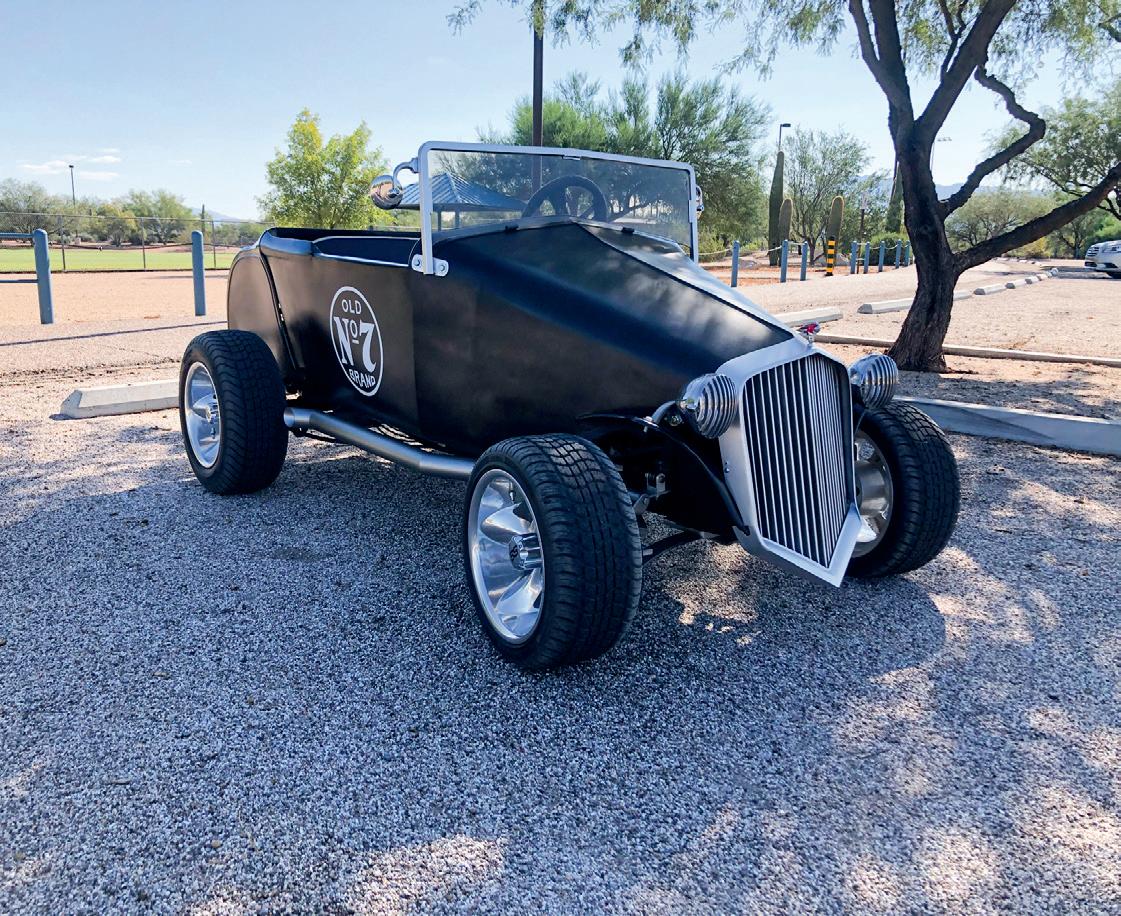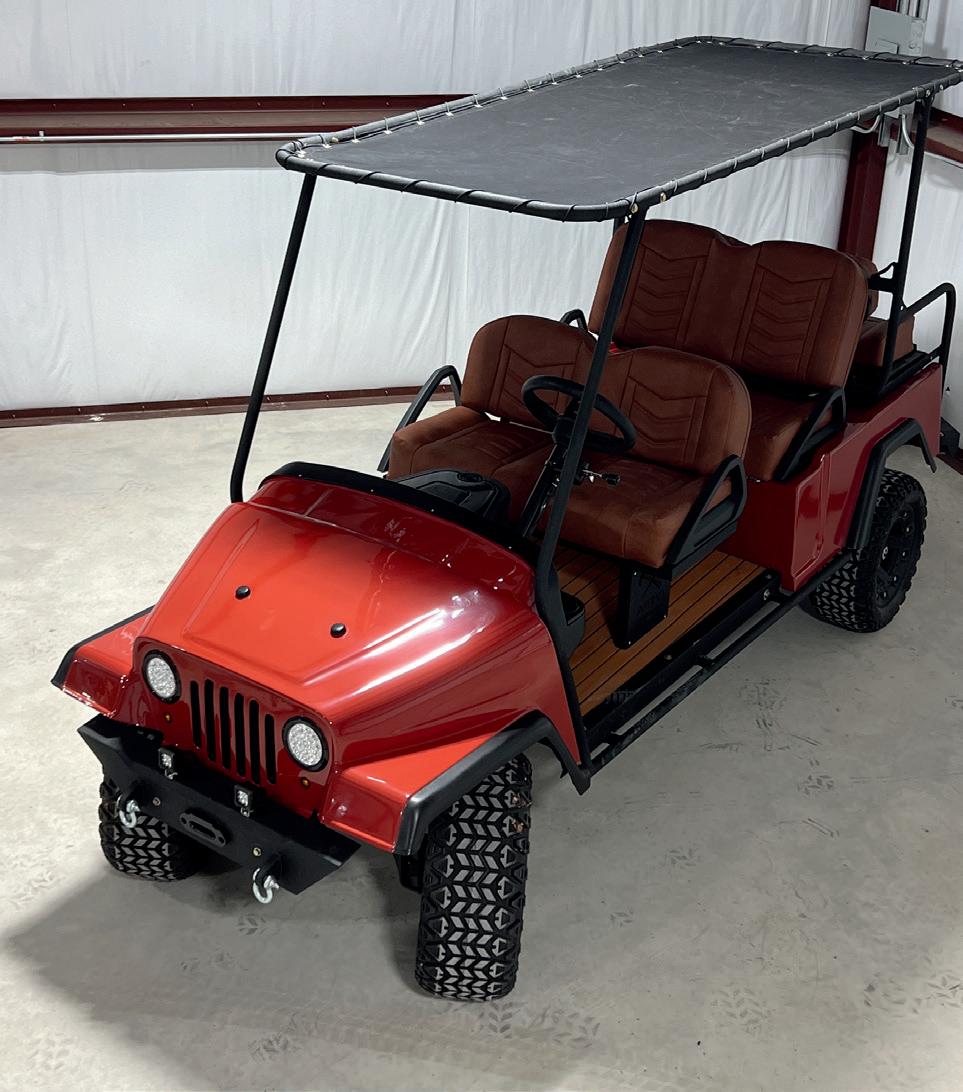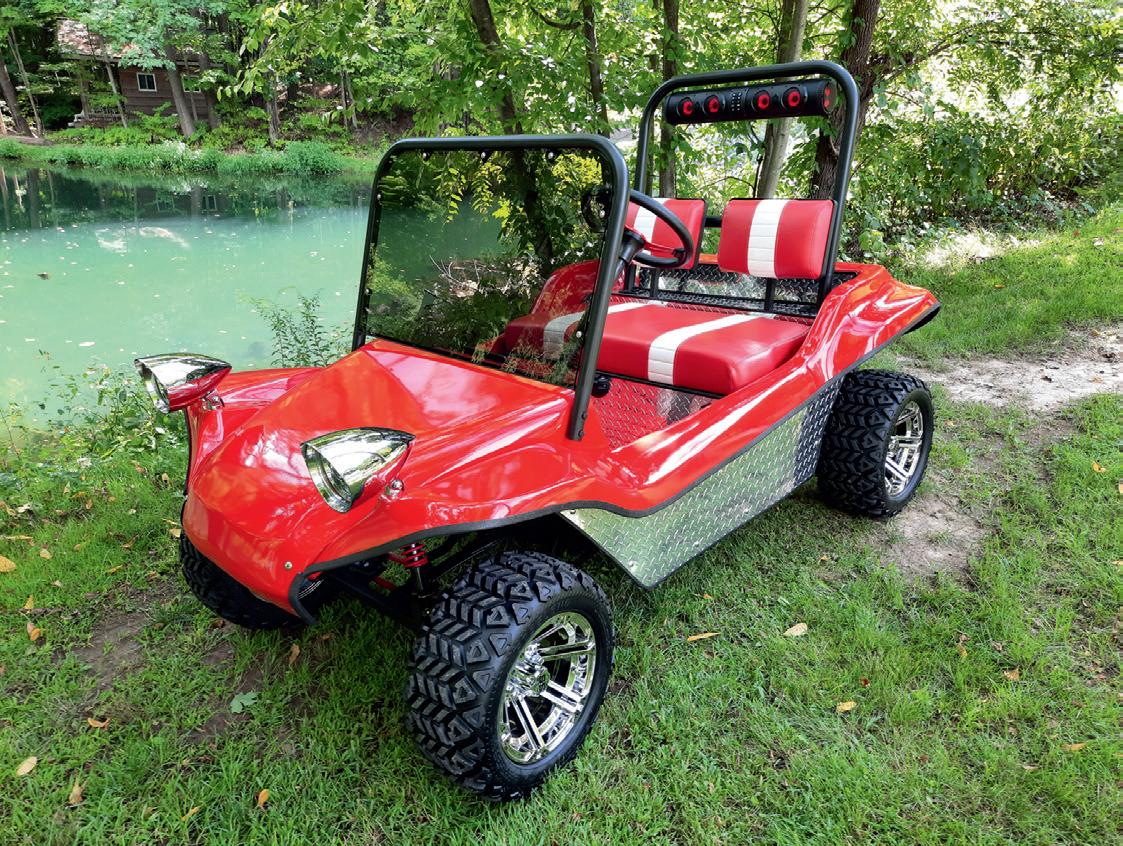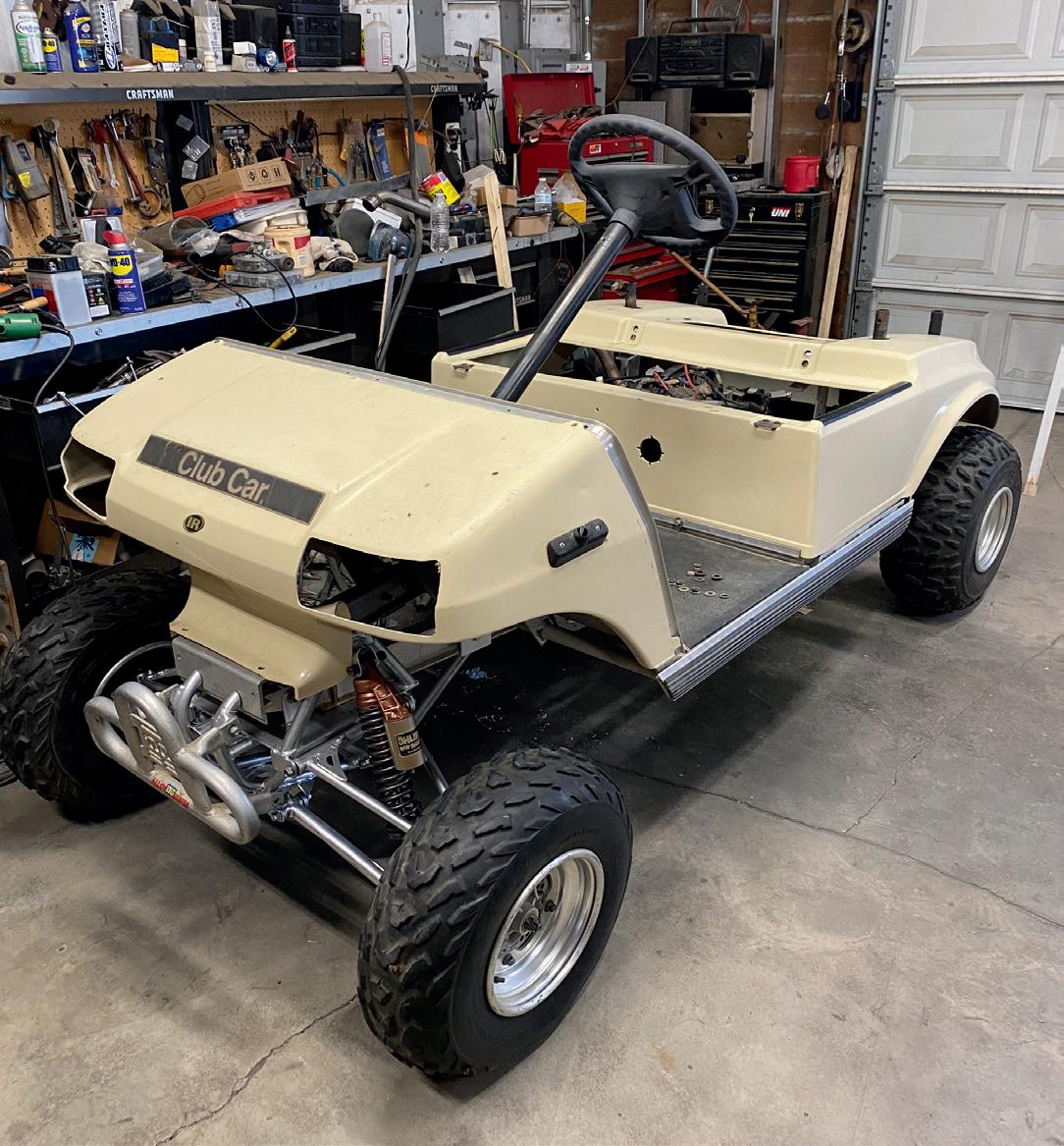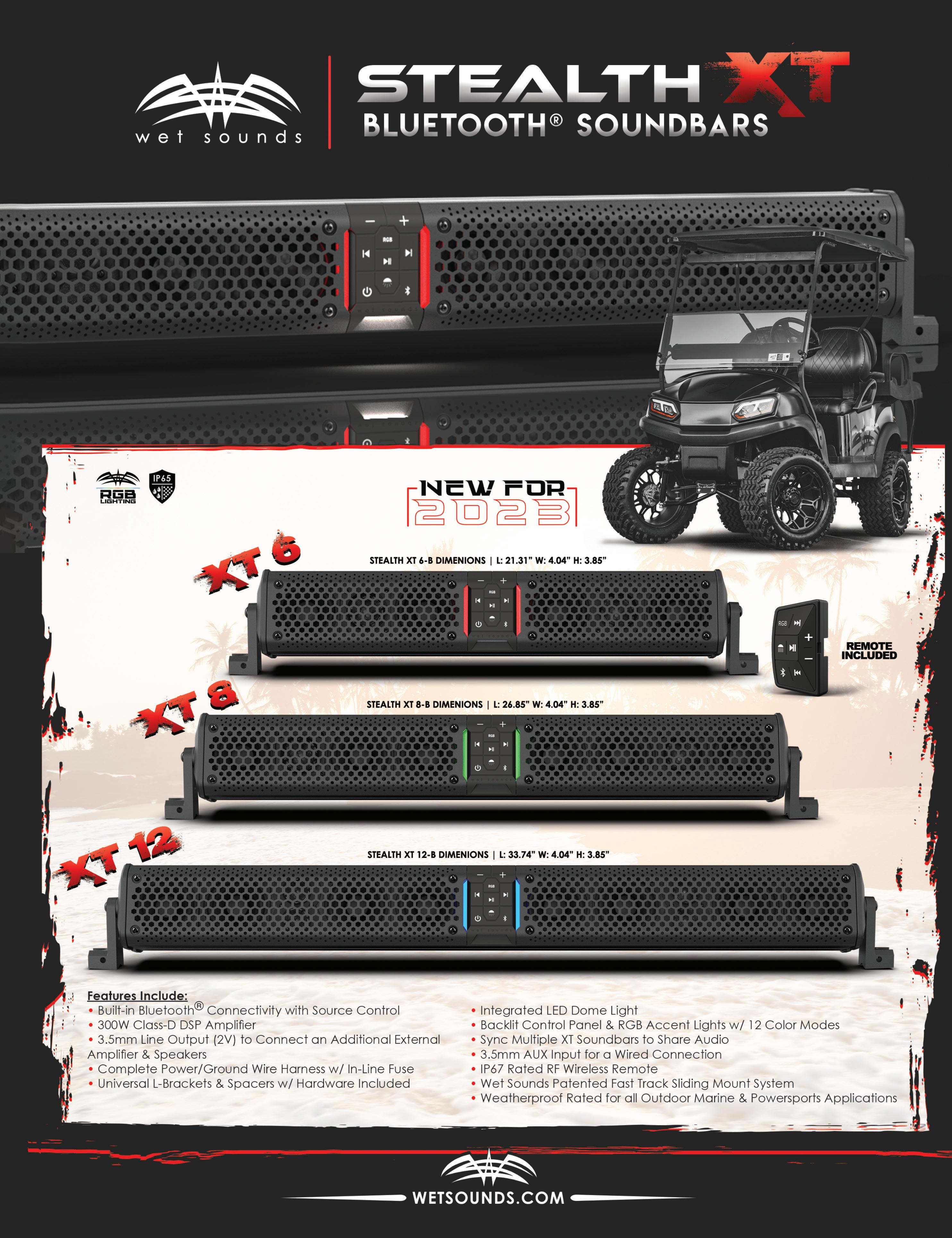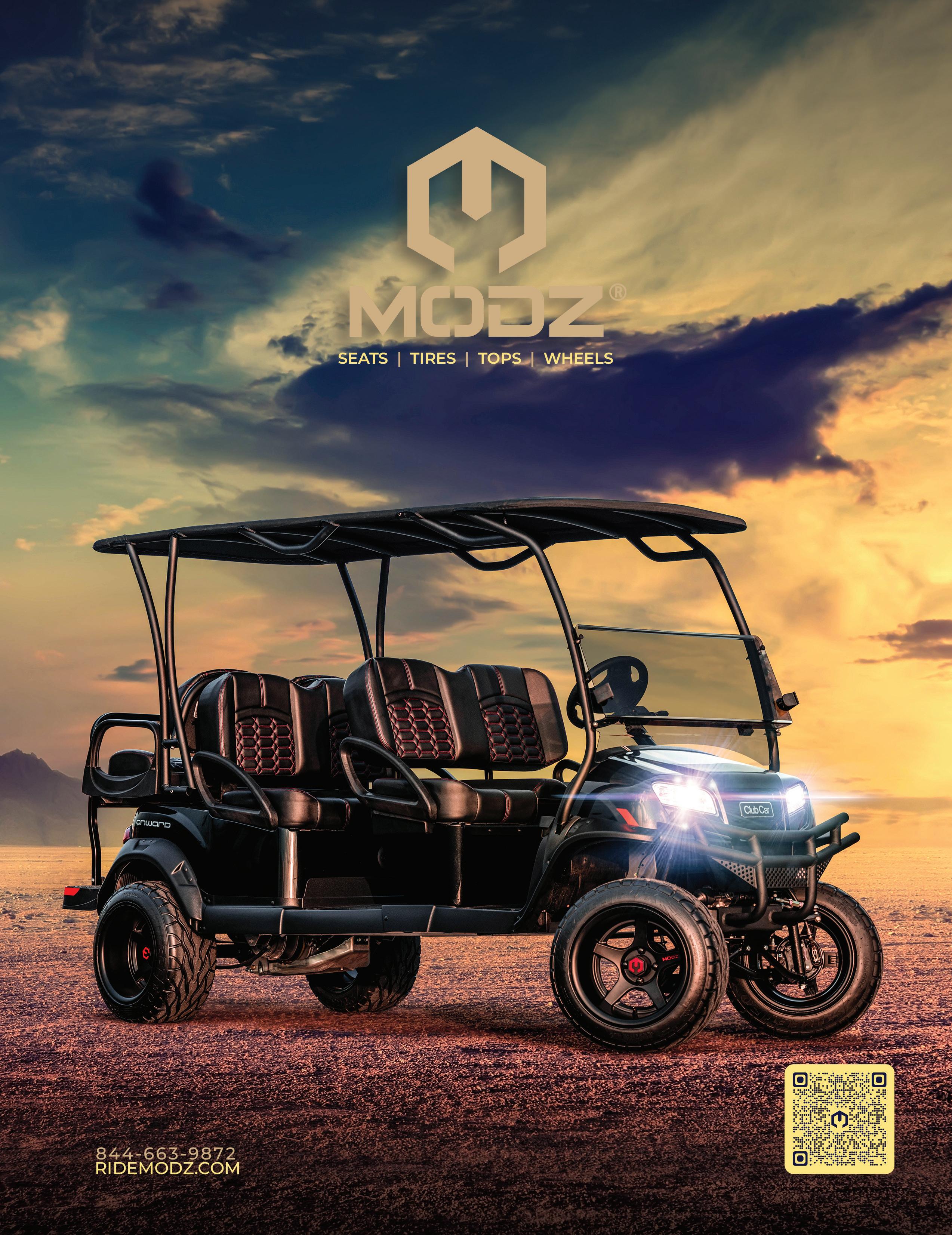


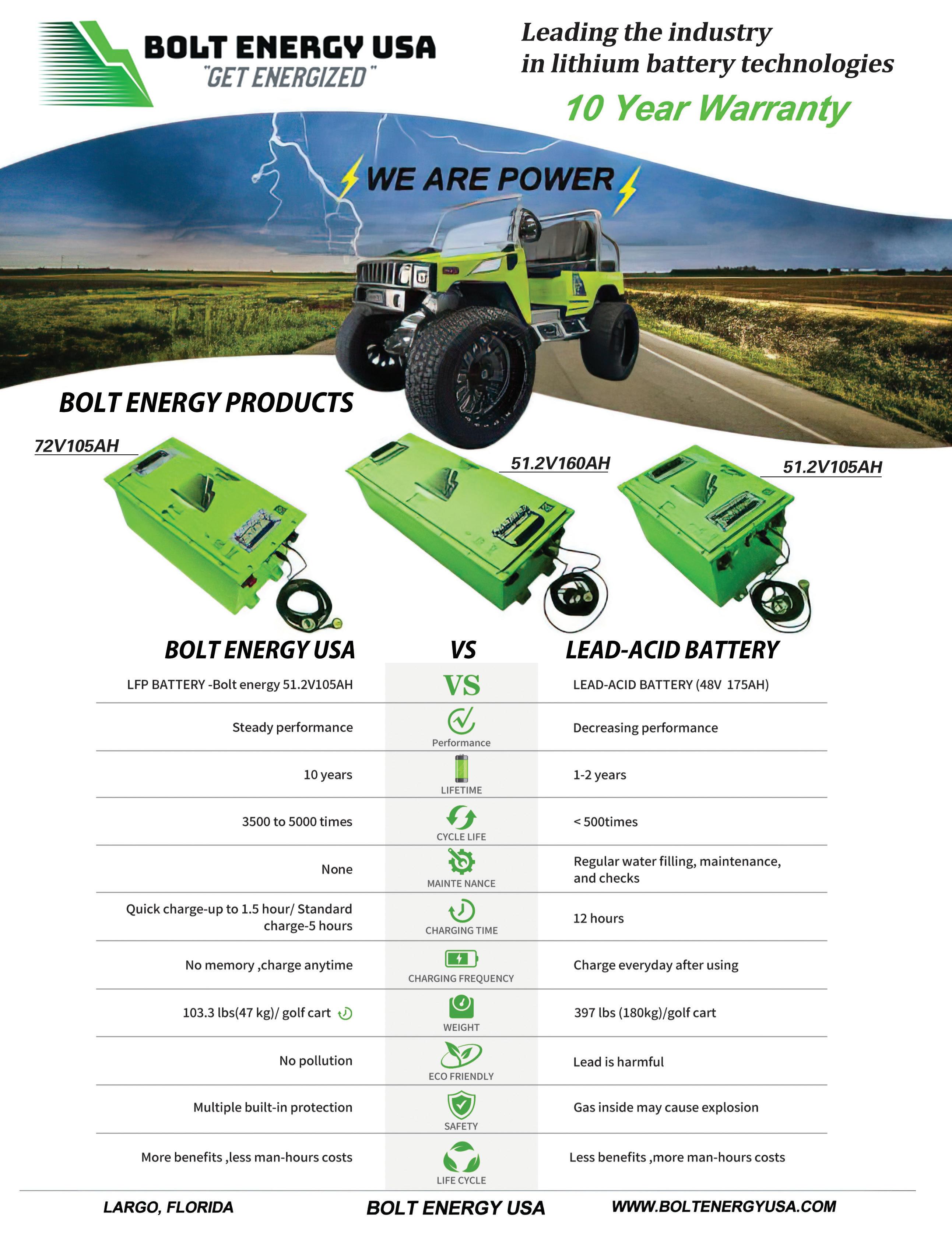



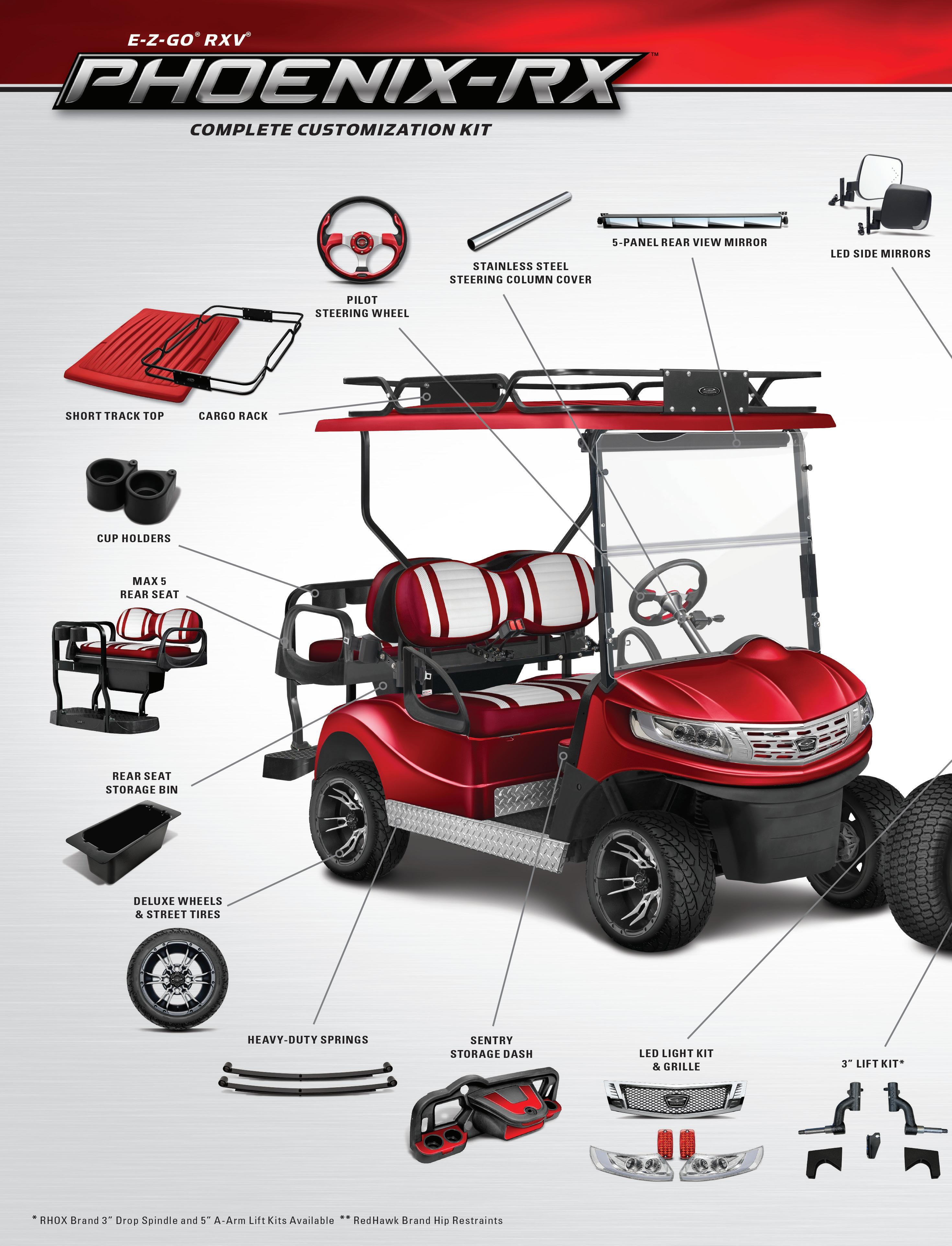





















Another January passed another PGA Show in the books. The weather in Orlando was perfect. The Golf Carting Magazine team met with many of our advertisers and partners, and it was rewarding to spend time with the folks that make this publication a reality.

I’m always overwhelmed by the PGA Show. The sheer size of it is intimidating. But it never disappoints.
What struck me about this PGA Show was the vast number of electric cart brands that are all competing for market share. Everywhere we looked there was a shiny new cart brand. And they looked modern, sleek, high-quality.

In recent years, we have become more and more familiar with new EV brands outside of “the big three”. Tomberlin, ICON EV, Star EV, Bintelli, Evolution are all brands that have been firmly establishing themselves in the industry. Each year, these carts become more stylish, more feature rich, more polished.
But at this PGA Show, we were stunned to see an
abundance of new EV brands. The first thing we did in Orlando on Tuesday was meet with Aaron Gouldie of Golf Cart King and his team at their rental house in Renuion. They were showcasing their new golf cart called Atlas and I was extremely impressed. The following day we visited at least another halfdozen EV cart exhibits and were blown away at how modern and stylish they were. For instance, there’s Vantage, Vivid, EV Titan, Trojan EV, Pilotcar, just to name a few. And believe me, there were many more.
It got me thinking and I asked myself, can this industry accommodate 30, 40, 50 electric vehicle brands? I know the future is all about NEVs and LSVs and the golf cart community model is flourishing in places like the Carolinas, Georgia, Florida, Texas, California and Arizona. At some point, one would think, that the pace of growth would slow, right? Or maybe just the opposite will happen. Who knows. But I do know that there is no lack of options for someone looking for a good-looking, feature-rich NEV. You won’t get one under $10K though. It sure isn’t like the old days.

Happy carting and enjoy this April 2023 edition of Golf Carting Magazine.
Trevor Rose Senior Editor Trevor@golfcarting.com

MAGAZINE
GOLF CARTING // Issue 35 // April 2023



Senior Editor: Trevor Rose - trevor@golfcarting.com
Creative Director: Troy Merrifield - troy@golfcarting.com
Graphic Designer: Tanner Merrifield
Production Director: Christian Amico - chris@golfcarting.com
Staff Writer: Kelly Madden
Staff Writer: Josh Delsota
Staff Writer / Social Media: Tony Benjamin
Golf Carting® is published monthly by GC Media Group, LLC. Reprinting in whole or by any means- electronic, graphic or mechanical, including photocopying or information storage and retrieval systems is forbidden without written permission from the publisher.
Advertising opportunities and inquiries to: chris@golfcarting.com
Editorial contributions are welcomed, but editors recommend that contributors contact us first. Contribution must be accompanied by return postage, and we assume no responsibility for damage or loss of material. Manuscripts must be typewritten, and all photos have to have captions. Photo model releases of all people in photos must accompany manuscript. GOLF CARTING reserves the right to use material, and we reserve the right to edit material to meet publication requirements. E-mail contributions or inquiries to: trevor@golfcarting.com
WARNING: Certain action photographs depicted in this magazine are potentially dangerous. The drivers and vehicle occupants seen in our photos are experienced professionals. Do not attempt to duplicate any stunts. Wear a helmet and safety restraints while operating a Golf Cart, and never drive beyond your capabilities. Do not drink and drive while operating a Golf Cart. We also encourage you to “Tread Lightly” while respecting the outdoors and other outdoor enthusiasts.
Use your head and enjoy the ride!
Stay
https://www.facebook.com/golfcarting
www.golfcarting.com




RELiON® Battery, a global leader in the development of lithium batteries, today announced their next generation portable power source, the Outlaw™ 1072s. Developed with the safest and longest lasting lithium iron phosphate (LiFePo4) chemistry, the Outlaw is powerful enough to run or charge essential electronics anywhere.
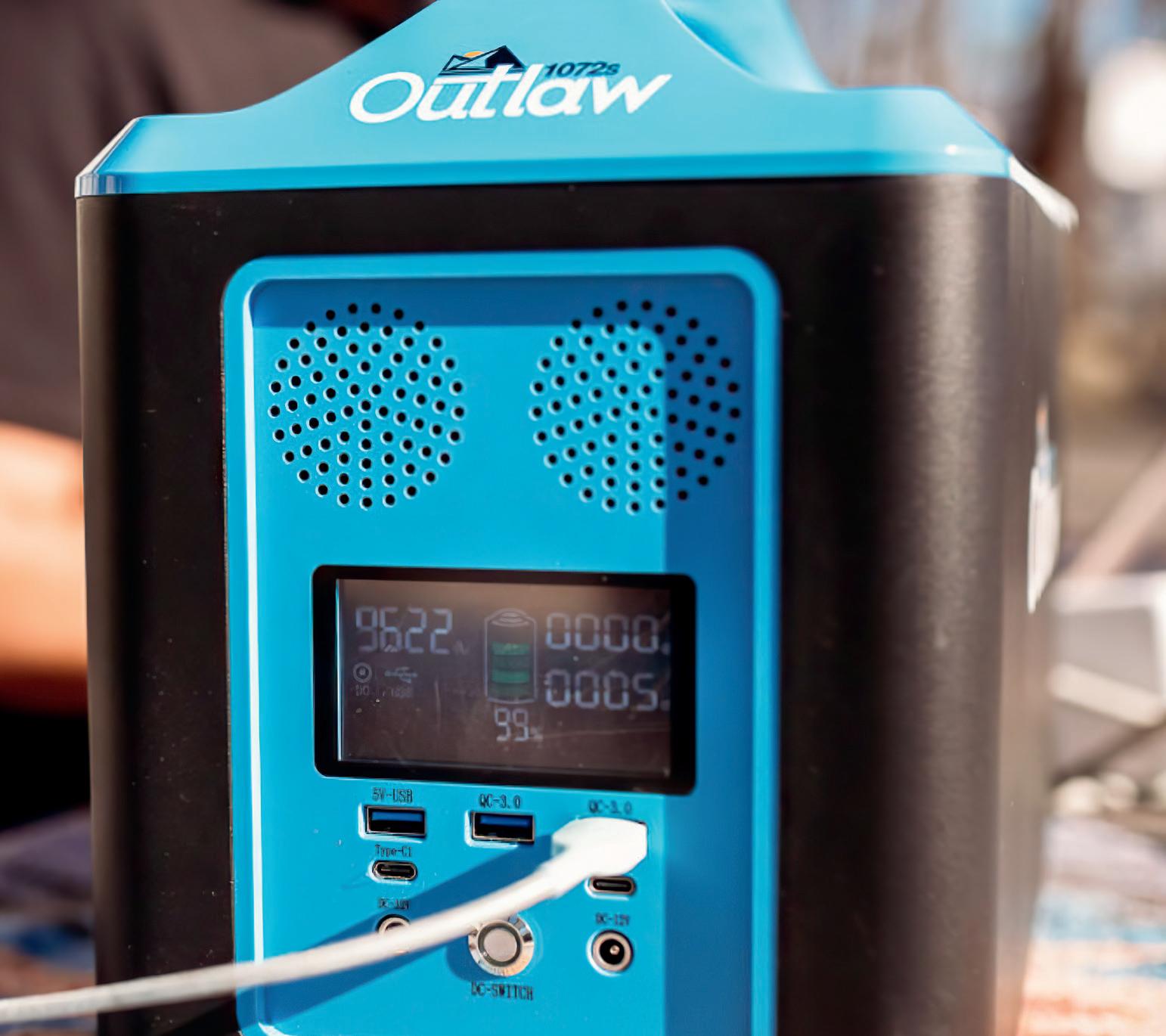
“The Outlaw 1072s is a safe, reliable option for all of your power needs wherever and whenever you need it – from camping and outdoor parties, to an alternative home power source, or even as an emergency backup,” said Eric Lindquist, VP and General Manager, Power Systems at Navico Group. “We are thrilled to enhance RELiON’s portfolio in the portable power space, and to continue providing premium lithium battery options for customers looking for long-lasting, convenient solutions.”
With a sleek lightweight design and fresh features, the next generation Outlaw 1072s enables adventures of any kind. From laptops and lights to TVs and refrigerators, the Outlaw can power small to medium devices and appliances. The inherently safe LiFePO4 technology delivers seven times longer lifespan compared to other lithium options on the market with 3500 cycles. The portable power solution offers high battery capacity with 1000 watts continuous and 2000 watts peak. Additionally, it can be charged at home or on the go with either an AC wall charger or in the sun with 12-25V/160W max solar input charging.
Designed for a variety of applications, the Outlaw features two AC outlets, three USB-A, two USB-C, two barrel jacks at 12V, 12V car port plug, and an EC5 30amp DC port. The internal Battery Management System (BMS) and UL1642 certified internal cells provide several layers of protection against things like under voltage, over voltage, over current and short circuits. Other features include a built-in LCD screen displaying voltage, watts in/out and remaining run time, as well as a pure sine wave inverter to power sensitive devices.
“The dedicated team behind our products have been in the industry for more than 20 years and have 190 years of combined battery experience,” added Lindquist. “We pride ourselves in being the expert in the industry and continue to demonstrate it through the innovative products we develop. As lithium batteries continue to gain traction, we are excited to be leading the way with our portfolio of products that deliver unparalleled power and performance.”
Key features of the Outlaw 1072s include:
• Long lasting with 3500+ cycles
• Multiple ways to use with several output ports for a variety of application
• High capacity – 921.6Wh (72Ah) LiFePO4 battery capacity with 1000W continuous and 2000W peak
• Easy to recharge with AC wall charger or solar panel compatible 15-25V 160W (Max)
• No fumes or noise like traditional generators and no maintenance required
The Outlaw 1072s will be on display at the Navico Group exhibit at boot Düsseldorf. For information about RELiON Battery and its lithium battery options, visit https://relionbattery.com/
RELiON® Battery is part of Navico Group, a division of Brunswick Corporation, (NYSE: BC), and is a global leader in lithium batteries powering a range of applications including recreational vehicles, marine, solar-powered solutions, and more. The company is on a mission to power the world’s transition to lithium energy storage, ethically. RELiON helps customers challenge and overcome their limits by offering a range of high-quality battery products that continue to pave the way forward to a greener and more efficient future for energy storage. The company is dedicated to giving back by donating one percent of annual revenue to environmental causes through its 1% for the Planet membership. For more information about RELiON, please visit relionbattery. com.
A division of Brunswick Corporation (NYSE: BC), Navico Group is the world’s leading supplier of integrated systems and products to industries ranging from marine to recreational vehicle and beyond. The Navico Group portfolio is comprised of industryleading brands in power management, digital control & monitoring, networked devices, and marine electronics. Some of the many brands that make up Navico Group include: Ancor, Attwood, B&G, BEP, Blue Sea Systems, C-Map, CZone, Garelick, Lenco, Lowrance, Marinco, Mastervolt, MotorGuide, Progressive Industries, ProMariner, RELiON, Simrad, and Whale.

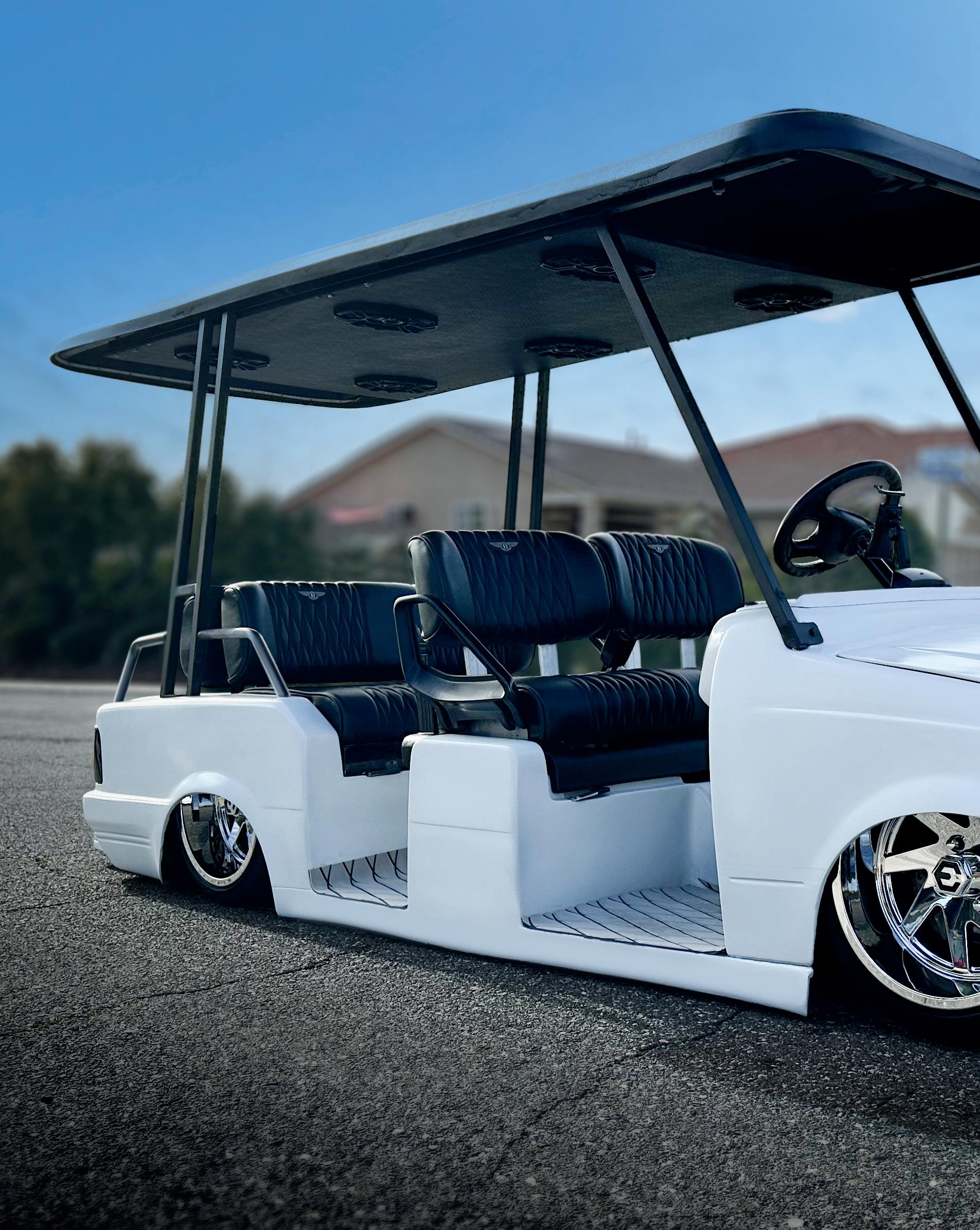
We always love the creativity of our readers and receiving submissions to check out what may be our next cover cart. This cart comes from the creative mind of Matt Townsend out of Murrieta, CA. There have been a lot of interesting carts manufactured over the years, and some you just never look at twice. But we could have never imagined a 2005 Western Country Golf Car would grace the cover of the mag. It goes to show you that little details can make a cart. This issue’s cover cart that we dubbed “Classy Cruiser” takes inspiration from a Bentley. We sat down with Matt to get the lowdown on his cart and what hides under the Western body. We hope you enjoy!

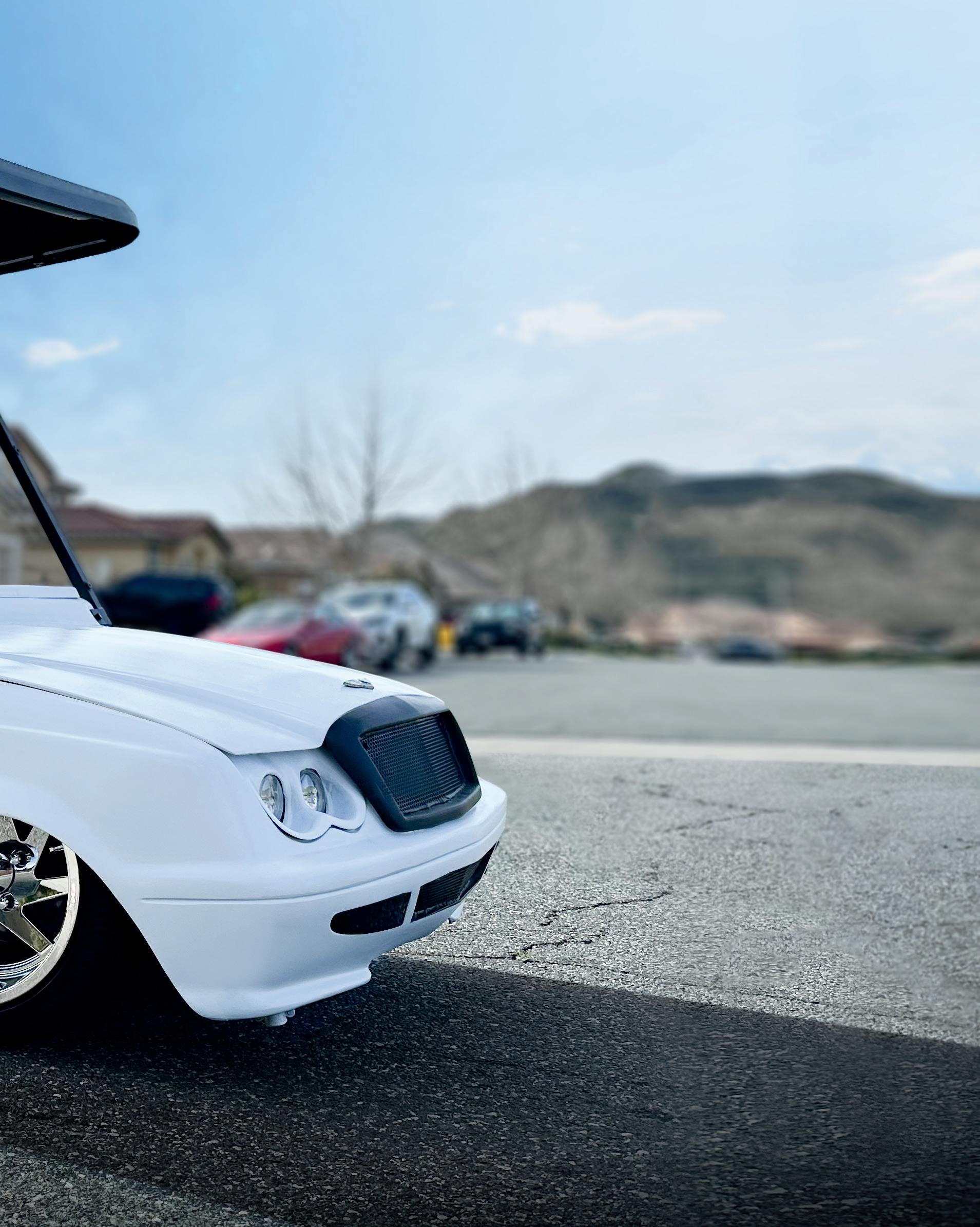
Hi Matt, can you tell us about this custom build?
I found this cart abandoned in a garage from a friend -- it had not been running in years. I’ve always wanted a specific vehicle body to build, so when I saw it was a 6-seater, I knew this was the one. Over the past year I stripped it down to the frame and verified the electronics were useable. After we knew it had good "bones" we started cutting. We narrowed the axles 6" front and rear to tuck the 14" rims. We notched the middle seat and body to accommodate the tires sitting inside the body. We fabricated a 3-link suspension front and rear and mounted 6" air bags. A 3-gallon air tank and VIAIR 450 compressor are shoehorned under the hood along with 8 solenoids for "front, back and side-to-side" adjustment of the suspension.
For the stereo, we needed enough sound to stand out at the local campground. A 6,500-watt RMS Rockville amp was placed on a fabricated rack under the hood to power the six 6x9's in the roof and two 3.5" speakers in the dash along with the 12" Alpine bass tube tucked under the rear seat which was sectioned to accommodate the massive woofer to appear "stock". It’s enough bass and sound to flex the seat foam on all three rows, and playing the music is an Alpine 10.9" touch screen.
Playing off the Bentley theme, we had Ceaser's Custom Upholstery mirror the interior out of a 2019 Bentley flying spur.
With just a single picture he was able to create a scale model including the perforated leather and diamonds, also blending the logo in each backrest, including steering wheel. We finished it off with a satin white paint and four coats of satin clear to keep it classy.
I was able to get this cart street legal and plated from the California DMV to cruise the streets with the 48V-105 AH RoyPow lithium battery. All the 12V accessories are powered by a 12V-100AH lithium RV battery for a long runtime. All and all, it was a fun build. I’ve always wanted a 6-seater with attitude, and I think we nailed it. The cherry on top was the Bentley key we cut and brazed on the golf cart shaft to work in the factory key box.
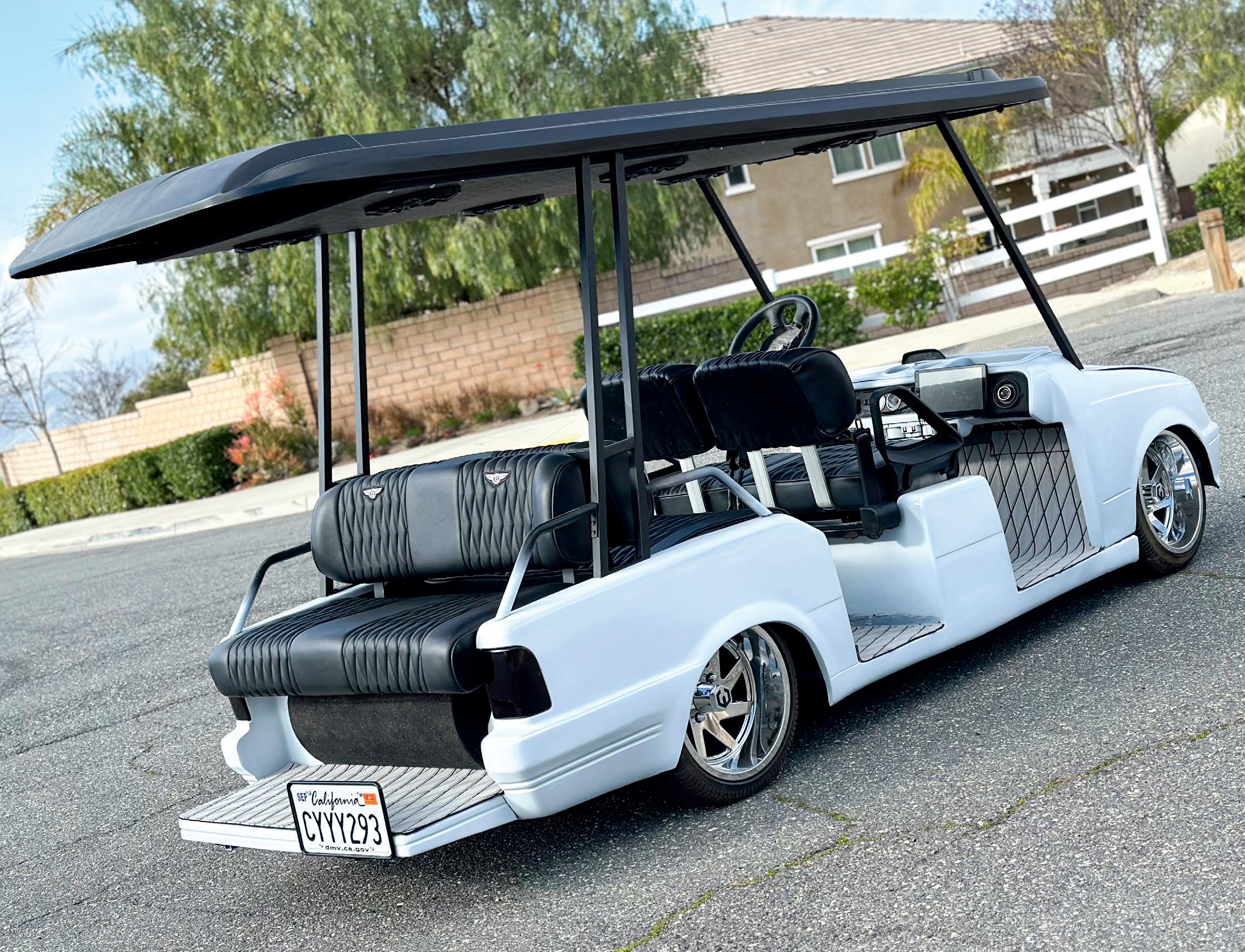
Does this build have any custom fabricated parts?
• Custom perforated leather diamond tucked seats with Bentley patches stitched in
• 3-link front and rear suspension
• I used the factory rack and pinion steering and flipped it over and attached to the frame to allow the axel to move up and down without interfering
• Sectioned the front and rear body to tuck the 14" rims leaving the body "stock" looking
• Narrowed front and rear axles
What aftermarket parts did you use?
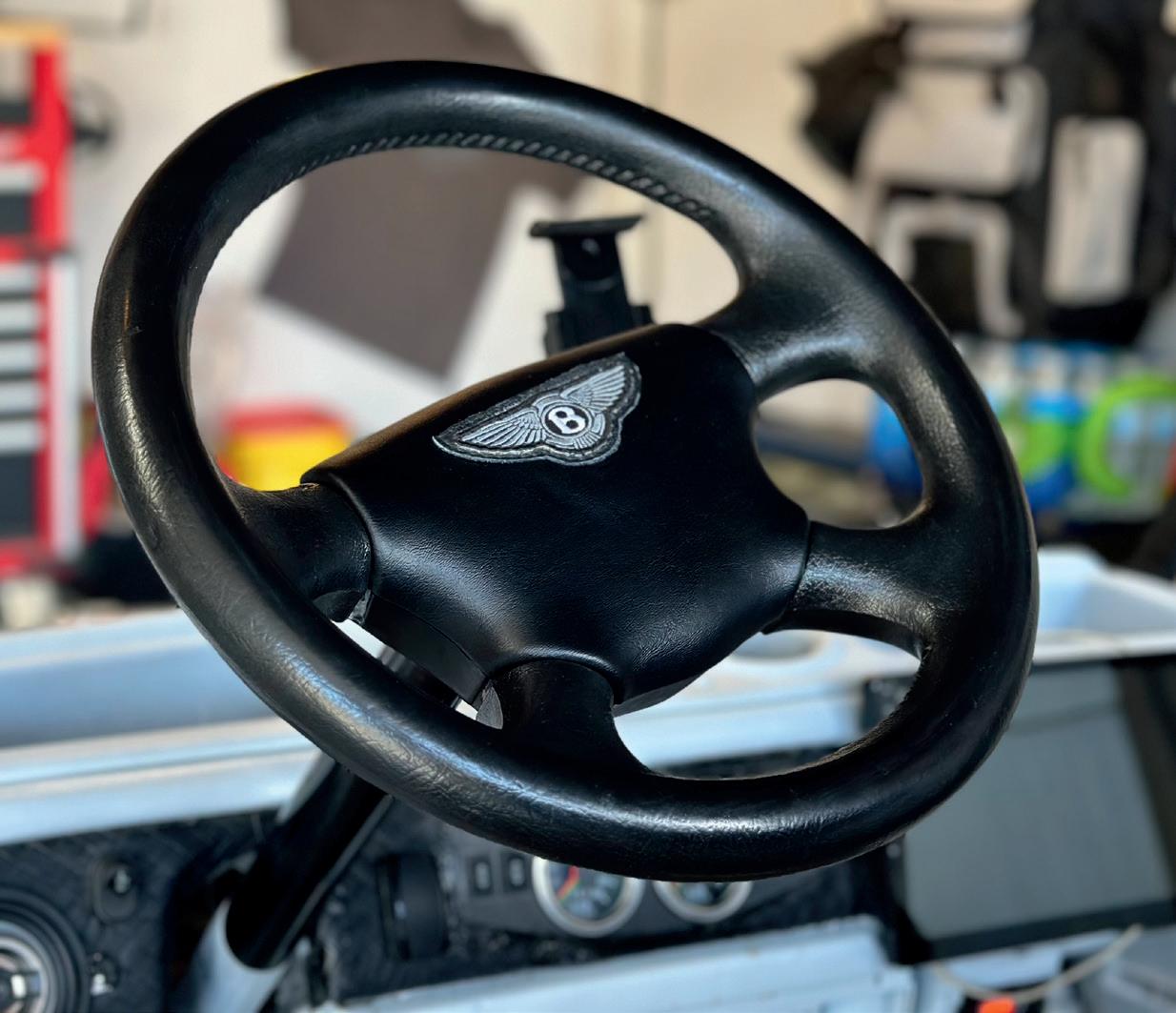
• Golf Carts Modified provided the custom black-and-white battery cables made by Ryan O'Rear
• Alpine 10.9" touch screen
• Six kicker 6x9's with Rockville 6,500-watt amp and 12" Alpine bass tube
• MODZ 14" Fury rims
• PPG satin white paint
• RoyPow 48V lithium battery
• 12V lithium RV battery
• LED headlights and parking lights
• Ceaser's custom upholstery

• 32' of RGB LED lights inside the roof
Can you give our readers some background about you and how long you have been building carts?
My style is from ‘90s mini trucks and wanting to modify golf carts with the same passion and customization. For decades golf carts were just "bolted on" and weekend builds to stand out from your neighbor. Today, golf carts are an extension of your personal style and a lifestyle. So, when I get an idea for a build, there's no limits. I put the same amount of effort into building a golf cart that someone would put into restoring or
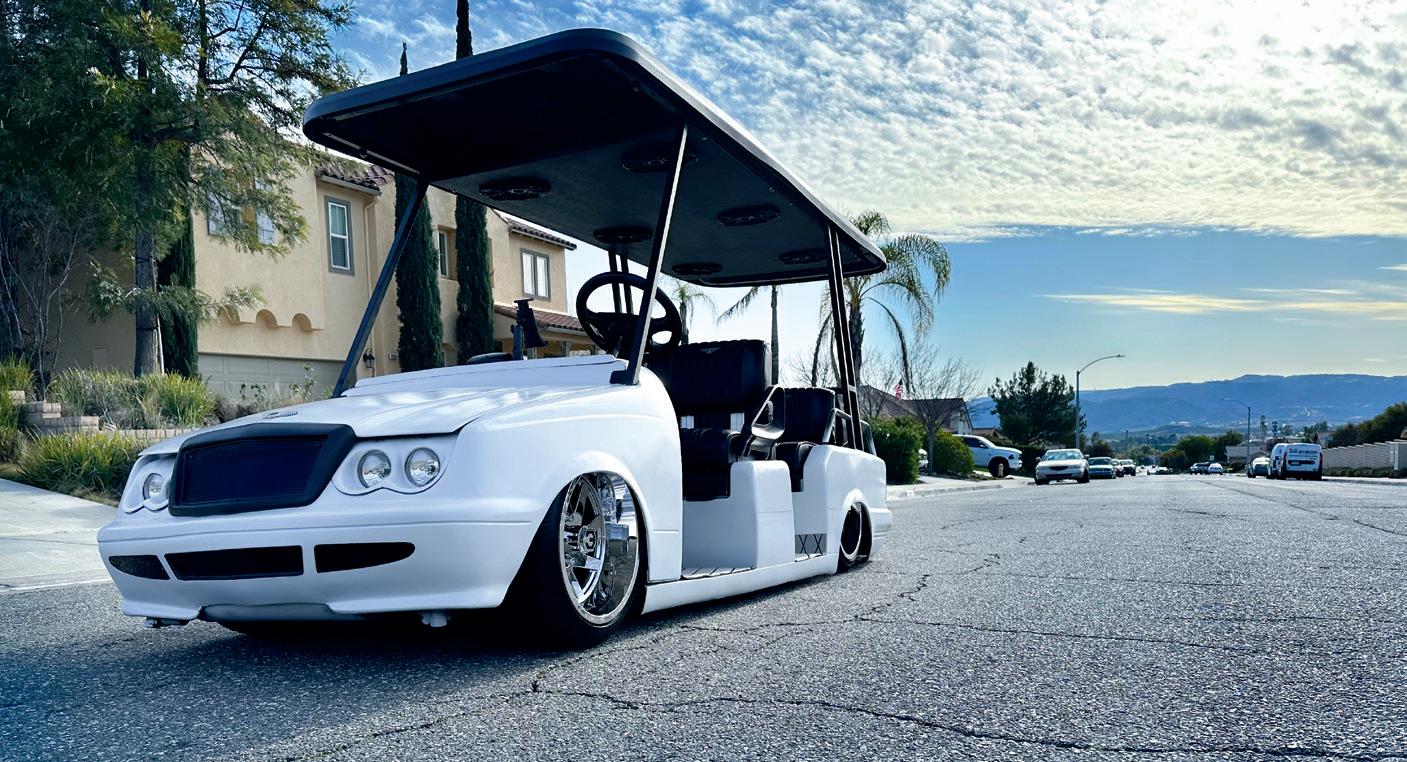

modifying their truck or car. I feel the future of custom golf carts is in its prime, and the next builds are going to be insane. It’s not about bolting on wheels and spray painting the cart over the weekend anymore. We are spending the time and money on these carts that most wouldn't spend on that old hot rod sitting in their garage. It’s a lot of fun and I love taking the ideas in my head and seeing the reactions from everyone.
I have great support for my crazy ideas. My co-builder Shelton Burdick knows just how to push me into what could be a terrible idea, yet help me build some insanely cool carts. So, the future has some one-off loud and fast carts coming.
Thank you to everyone that supports me -- my wife for allowing me to spend what I told her I did on parts. (That is until she finds the receipts.) I want to thank Shelton for having a stronger back than me and always helping lift heavy parts, and to Golf Carts Modified for the parts and the support. I would also like to thank the online community at Extreme Golf Carting on Facebook. It is an awesome resource for motivation, and they help when we get stuck on that mystery wire. GCMag
DDeep-cycle flooded lead-acid batteries continue to be the most popular batteries for golf and personal transportation vehicles (PTVs) because they are reliable and cost-effective. But improper maintenance and usage can cause corrosion and sulfation, the formation of lead sulfate crystals on the battery’s plates. This can impact battery performance and life. Fortunately, both are largely preventable with regular maintenance and proper charging.
Corrosion occurs primarily during charging when the battery releases hydrogen gas, water, and acid. This can settle on the battery’s components, leaving a white, crusty material around the terminals and cables. If not removed, this corrosion will restrict energy flow through the terminals, affect performance and damage the battery. Frequently check your battery terminals. If you spot corrosion, immediately clean it away, following the directions in your owner’s guide.

Improper charging can also cause corrosion and sulfation.
Overcharging accelerates the corrosion of the positive plates and increases the amount of water loss that occurs during charging. Make sure your battery charger is functioning correctly, is adequately sized for the battery set, and has a charge algorithm recommended by the battery manufacturer.
Undercharging, on the other hand, can cause sulfation. Both can diminish performance and shorten battery life.
With overwatering, the electrolyte can overflow the cells and cause corrosion. This often occurs when watering batteries that are not fully charged.
Underwatering can cause sulfation, as the water lost during charging must be replaced. Follow your manufacturer’s recommendations for watering
Check fill levels and follow the directions for watering and charging in your owner’s manual, and never let the electrolyte fall below the plates.
Single-point watering systems, such as Trojan’s HydroLink™ Battery Watering System, take the guesswork out of watering. The system waters Trojan batteries in seconds and helps prevent damaging over- and under-watering.
DOD is the amount of charge left in your battery. Most battery manufacturers recommend that flooded lead-acid batteries never go past 50% D0D. Charge your batteries at the first available opportunity after each use. Higher DoD can cause corrosion.
While these maintenance mistakes may seem like small issues, they are not. Improper maintenance can damage or destroy your batteries and reduce the return on your investment.
To learn more, visit Trojan Battery Company or find your Local Authorized Trojan Dealer.



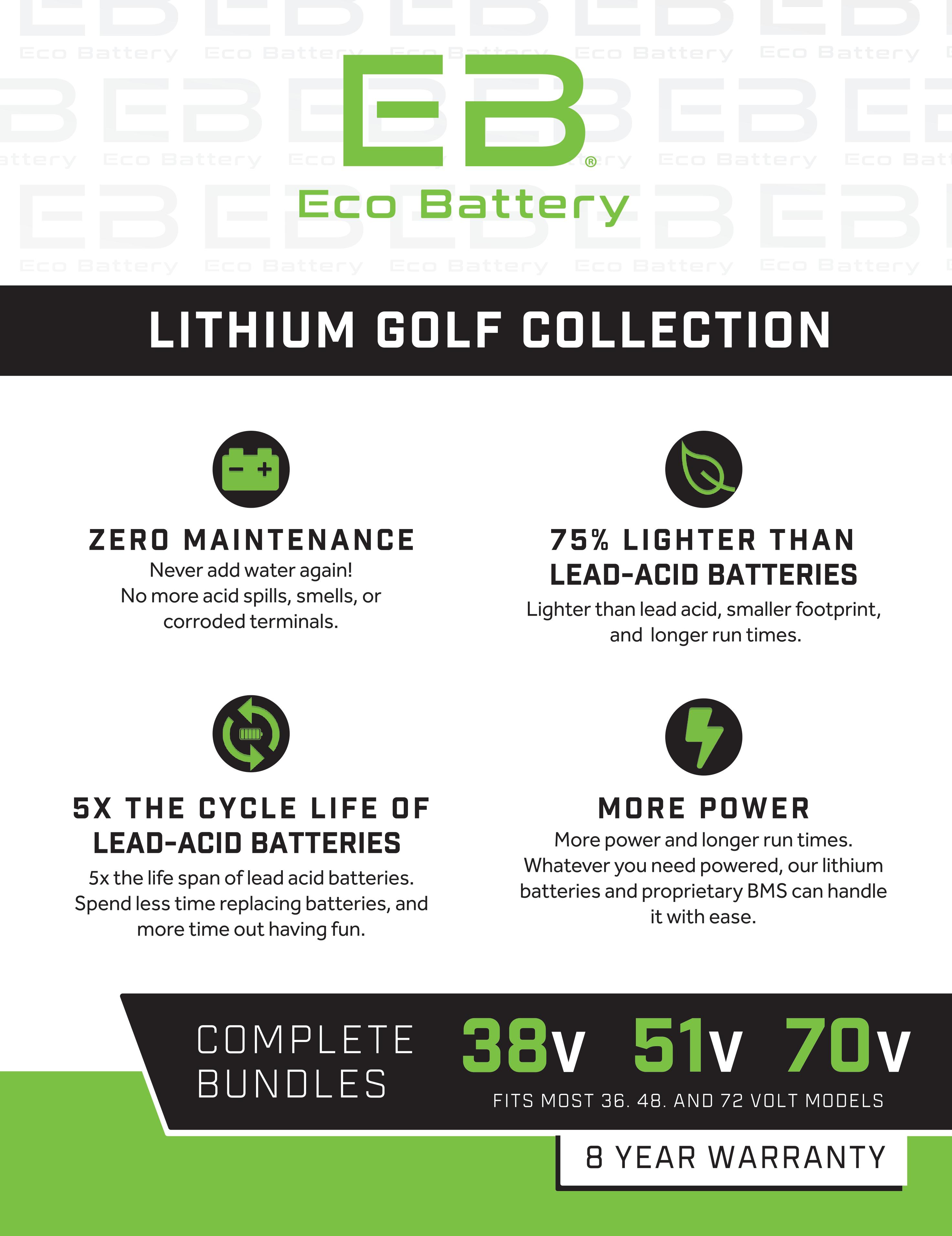

When you first get a look at one of Garia’s golf car models, it’s easy to see why the company refers to them as golf ‘cars,’ and not ‘carts.’

These top-of-the-line electric cars resemble the finest luxury automobiles, both in their dramatic design and car-like ride and features.
Garia was founded in 2005 in Copenhagen, Denmark, and was acquired by industry leader Club Car® in mid-2022 from the Lars Larsen Group. Garia also produces a full line of utility vehicles used for things like facilities management, delivery and transportation, municipal and public sector support vehicles and more. The President of Club Car said at the time of the acquisition, “Our product lines complement each other nicely with very little overlap.” Garia CEO Jakob Holstein added, “Club Car is the perfect partner and will immediately open new opportunities for growth across our entire product portfolio in the U.S. and
around the world.”
The respected traditions of Danish design and attention to detail are keystones of the Garia golf car brand, and it is likely you will never see a more impressive electric vehicle in terms of body style, aerodynamics, passenger comfort and innovation. Garia vehicles appeal to those who appreciate the finer things in life, not unlike those who prefer to drive a high end, luxury car.
Garia designs and manufactures a full line of luxury golf and leisure vehicles, all of which are street legal in the U.S.


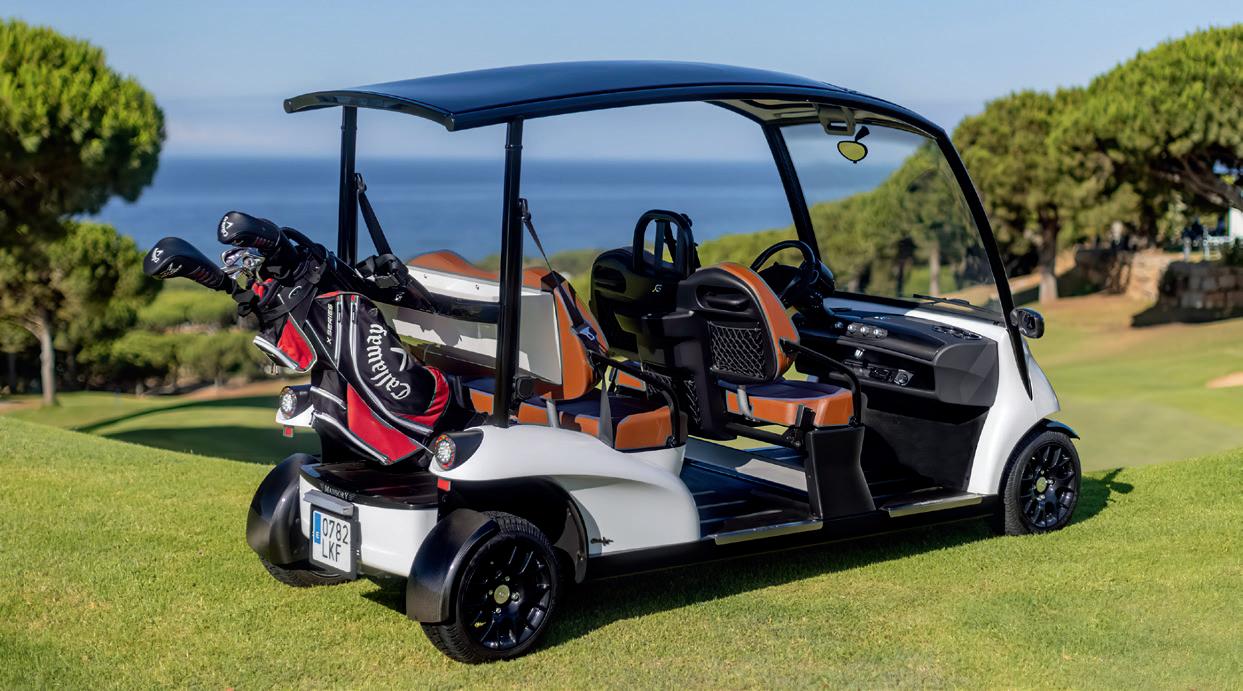
There are the VIA 2-Seater, VIA, 2+2, VIA 4-Seater, VIA 4+2 and the SuperSport models. As if the standard accessories and appointments on these cars were not enough to satisfy the most discerning buyer, Garia offers an extensive line of optional packages so you can design your car to your exact specifications.
The VIA 2-Seater is available in a Roadster, +2 or OFF X Lifted
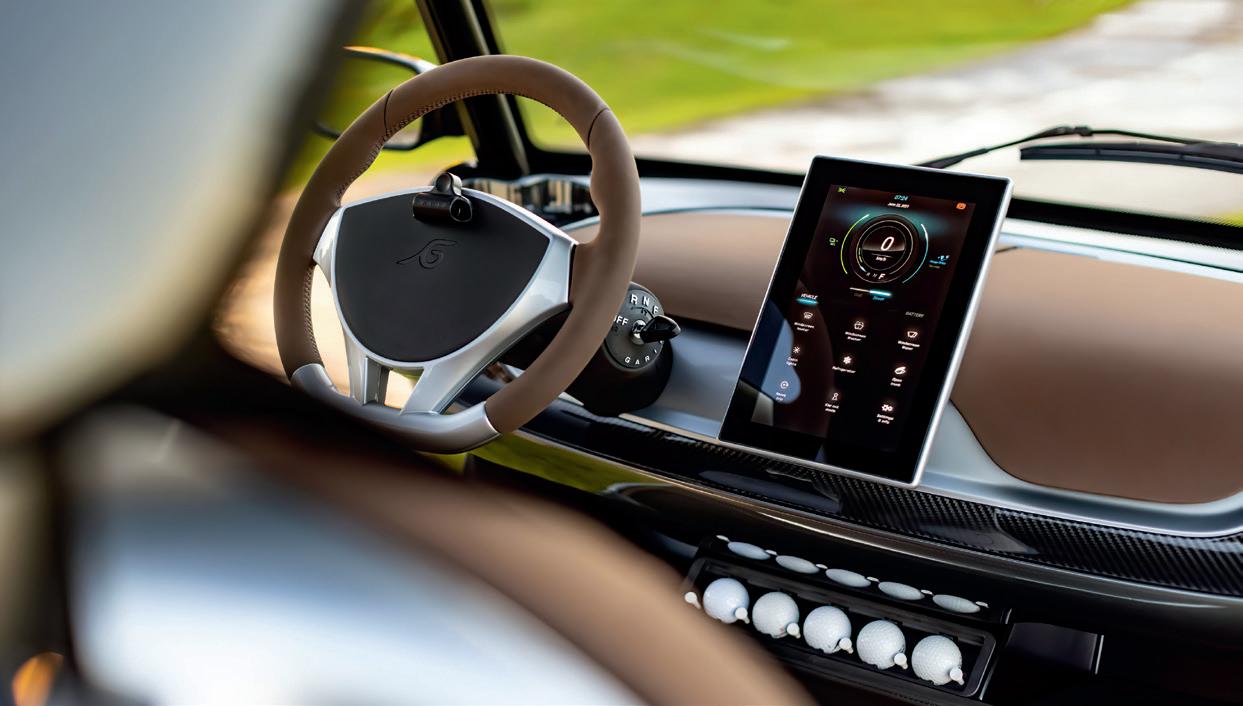
model, all of which are street legal. Like other Garia models, there are available package upgrades, called their Bespoke Collection, like the Premium Package, Mansory Collection Package, and the Black, White and Matte Packages. These golf cars offer 3 different seat design options, 11 unique paint schemes, 5 eye popping rim styles, and many more upgrades.
The company’s Mansory Package, (Mansory is a German company that specializes in the modification of luxury and exotic supercar vehicles), includes upgrades like an enhanced dashboard, instrument cluster, steering wheel, mud guards, bumper trim, side mirrors and more. Other available options on all Garia models include a refrigerator, Bluetooth® stereo system, and custom floor mats.
The VIA +2 configuration comes with 2, rear-facing passenger seats, a foot platform and safety handrail in the back.

The VIA 4-Seater offers 2 additional, forward-facing passenger seats, an extended smoked Plexiglas sunroof insert, seat belts, and a host of other upgrades. The VIA 4+2 model


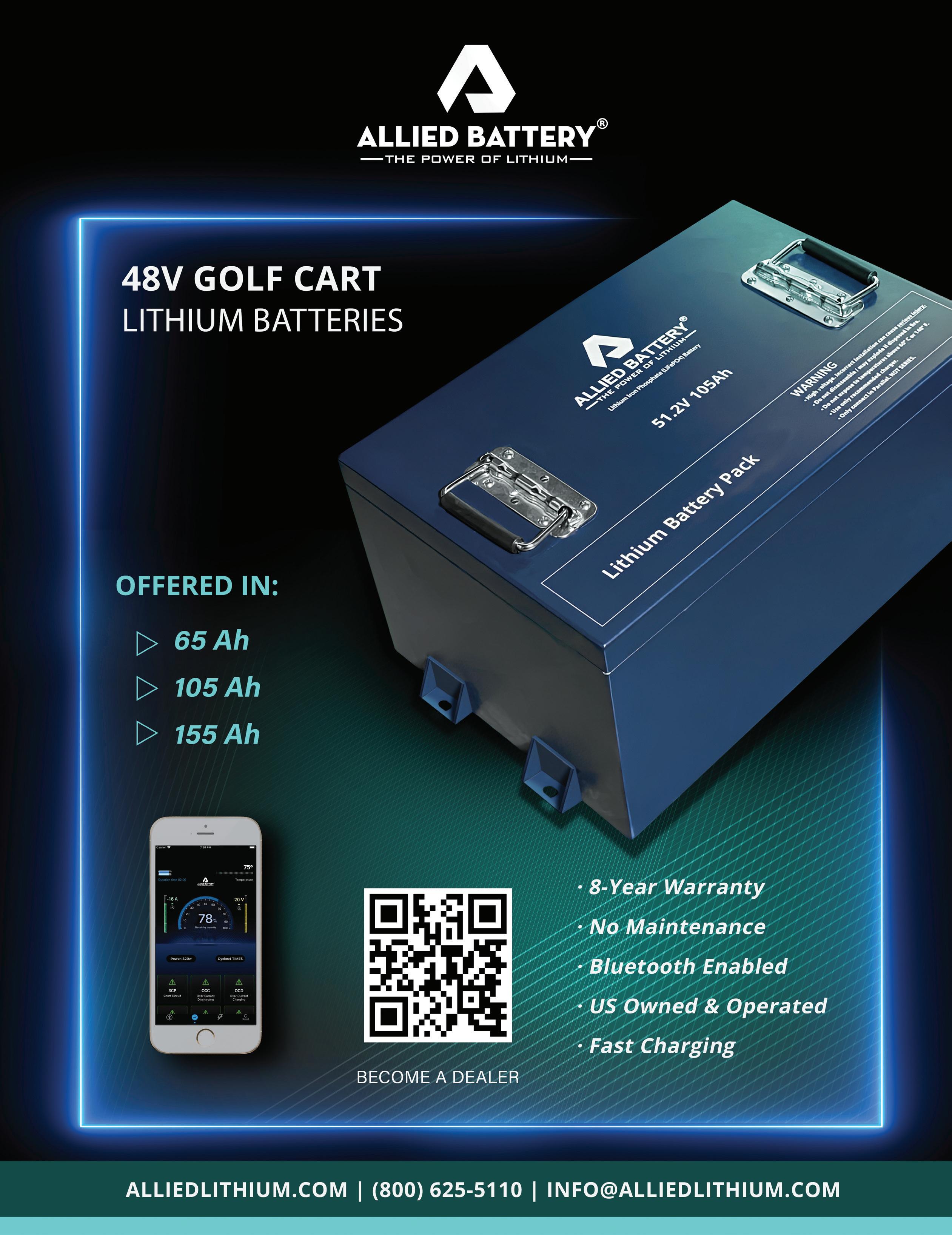
offers 4, forward-facing seats plus 2, rear-facing seats on the back of the car.
If there were ever a golf car that exudes luxury at first glance it would be Garia’s SuperSport model. This stunner offers Mercedes Benz®-inspired design points and the feel of driving a super car, and features a premium line of accessories and appointments like a back-up camera, 10.1-inch outdoor touch screen display panel, an in-seat sub-woofer, LED headlamps and taillamps, enhanced body trim package, 14inch aluminum Piano Black rims, leather seating and leather interior trim.
The Garia-Mansory Prism, a joint venture model created along with Mansory Design, is a one-of-a-kind car certain to turn heads anywhere from the golf course to the street. This car is equipped with Samsung® lithium batteries and an upgraded Curtis® controller capable of acceleration from 0 to 25-mph in just 2 seconds. Other impressive features include the 3 unique drive settings - Golf, Street or Race - fully adjustable by the driver, depending on the terrain and other performance factors. Other highlights include the Mansory carbon fiber dash, accessories and much more. This oneoff vehicle was created exclusively for the Garia-Mansory exhibition at the famous Geneva Auto Show, and many of Mansory’s highly acclaimed, premium design elements are available on all Garia models.
Garia models come standardly equipped with lead acid batteries and the company offers available upgrades to 120 Ah
or 180 Ah lithium batteries.
The exclusive, luxury appeal of Garia golf cars has not gone unnoticed by some notable celebrities who fell in love with owning the world’s premier golf or leisure vehicle and who have served as ambassadors for the brand, including racing legend Emerson Fittipaldi, PGA Tour golf champion Bubba Watson, IndyCar champion Ryan Hunter-Reay and country music icon George Strait.
When it comes to setting the standard for manufacturing eco-friendly electric vehicles, Garia is an industry leader. Protecting the environment is one of the company’s most critical goals, and 40 to 60% of their production facilities in Denmark are powered by sustainable resources like wind or hydropower.
All Garia models come with a 3-year warranty, with a 5-year warranty on the frame. A Garia dealer in North Port, Florida, said the cars appeal to a certain customer looking for something different. The attention to detail, premium exterior and interior finishes plus the ultimate in passenger comforts are offered in all Garia golf cars, and are evidence of the company’s mission to create the ultimate vehicle to match your lifestyle and passion for excellence.
If you’re in the market for a truly unique golf or leisure electric vehicle a cut above the status quo, Garia can build the cart of your dreams. Golf cars begin at around $22,000.00, and some package options are additional.

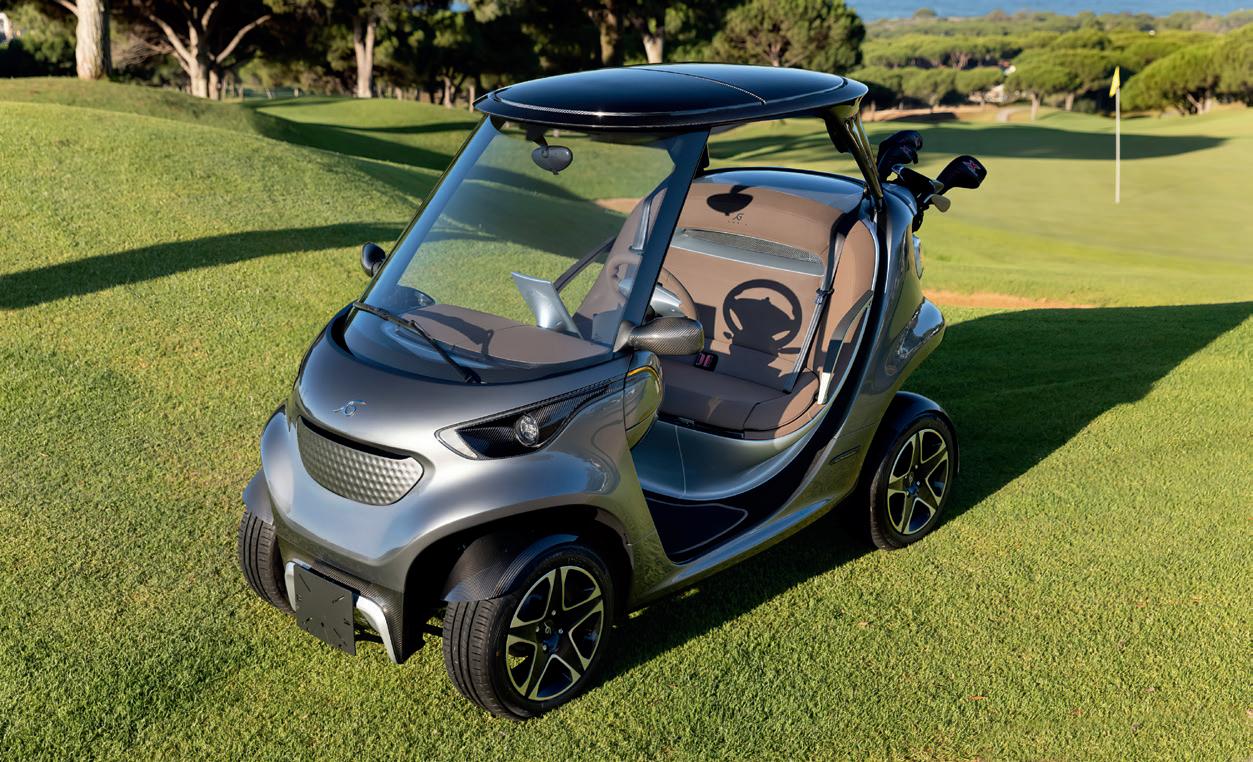



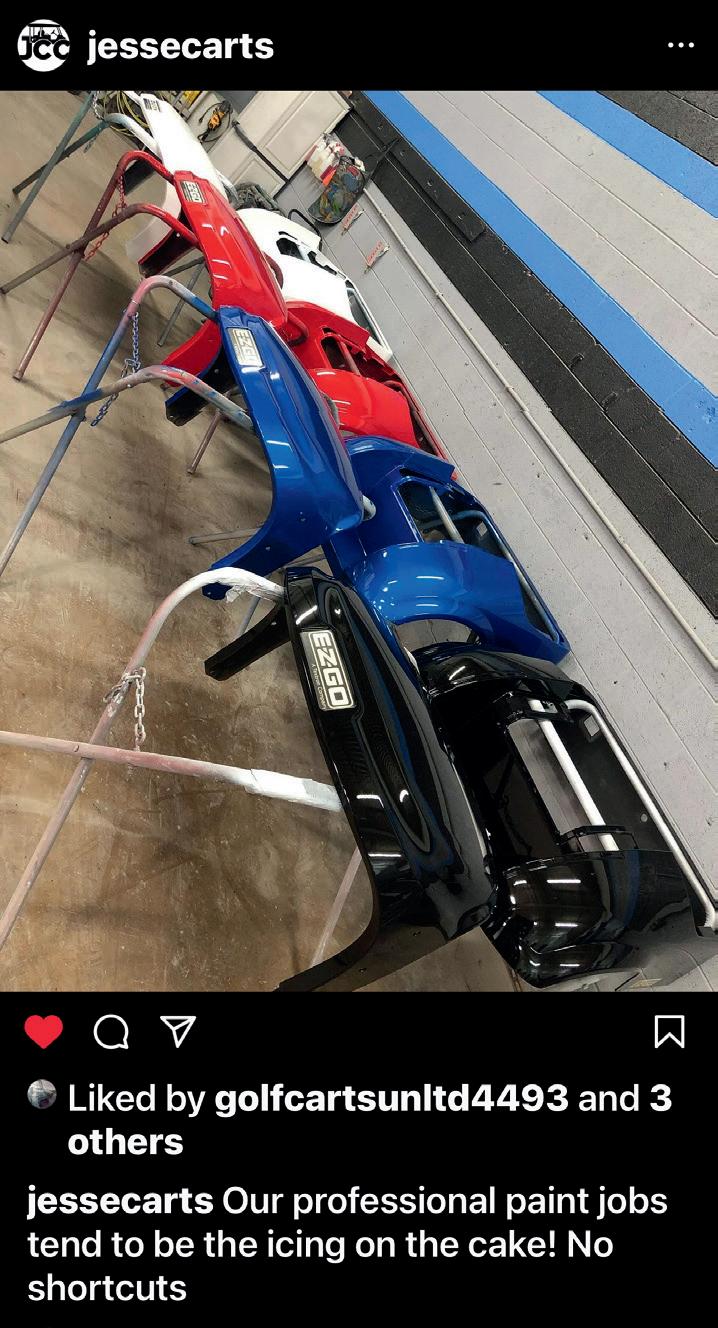


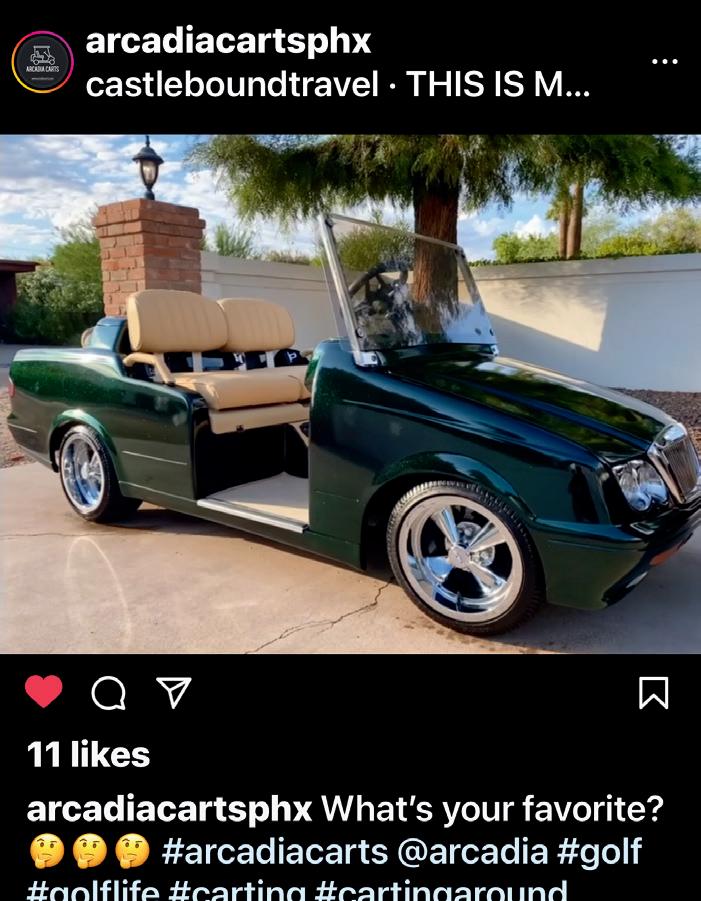
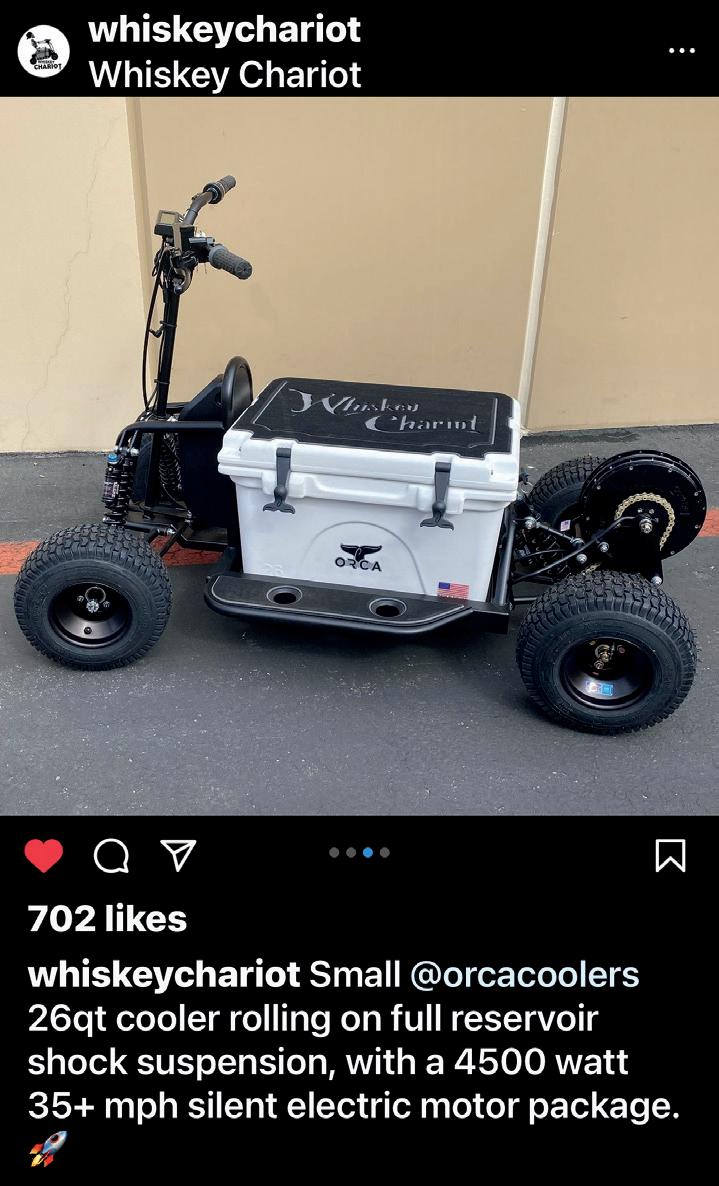

As the leading mini golf cart manufacturer in the U.S., Cricket Mini Golf Carts is quickly making a big name for themselves in the portable, lightweight cart industry.
Founded in 2018, Cricket makes and distributes their carts to all 50 states from their 12,000-square foot headquarters in Daytona Beach, Florida. Their engineering team represents over 45 years of golf cart design and manufacturing experience, which is immediately apparent when you see and drive their eco-friendly, collapsible vehicles. Cricket mini carts are an affordable way to easily navigate around an RV campground or vacation resort, campsite, outdoor music and sports venues, the beach or just cruise around your neighborhood.

All Cricket models are completely collapsible, allowing them to fit easily into the storage compartment of an RV or motorhome, fifth wheel, pickup truck and even most SUVs or crossover vehicles. This provides incredible convenience and the ultimate in portability without needing to trailer and tow your cart.
There are 6 unique Cricket mini carts available, each offering a long list of options and custom upgrades to create the perfect cart for any use.
The Cricket SX-3 was the original model that started it all
and is the perfect example of the company’s portability and compact design features. This collapsible cart fits easily into an RV or motorhome basement, a pickup truck and also most of today’s SUV and crossover vehicles. The SX-3 comes in 8 different color schemes, as well as the option to order yours in a custom color. There are 3 different seat color options, as well as the option to order a custom design, and there are dozens of other available options like oversized tires, 7 different top options, zippered rain enclosures, audio soundbars, LED light kits, Bluetooth® connectivity, remote controlled loading option and many more.
The SX-3 transmission is a 16:1 reduction gearbox, and the drive system is a single 36-volt magnet DC 800 watt motor. The electrical system is powered by three heavy duty, sealed 12-volt 35-amp/hour batteries. It measures 58-inches long when ready for transport, 32-inches wide and only 28-inches tall when collapsed. The SX-3 weighs just over 400 pounds. The starting price of this model is $4,699.00.
The Cricket RX-5 is another collapsible cart built by the company, and the base model begins at just $5,699.00. The RX-5 features the same transmission as the SX-3, a single 36volt magnet DC 800 watt motor, and measures 58-inches long by 32-inches wide, and folds down to 30-inches. This model weighs 420 pounds. The RX-5 features front and rear shocks

for an improved ride experience plus rack and pinion steering for improved handling. This model can seat 4 passengers comfortably and will reach speeds of up to 10 miles per hour depending on the terrain.
The Cricket ESV is the ideal electric vehicle for transporting 2 passengers around an RV campground, resort or other outdoor property in style and comfort. You can order one with all the available color and style options as on the company’s other models, plus available upgrades. The ESV has a direct drive, 30:1 reduction gearbox transmission, a single, 24-volt magnet DC 800 watt motor and 2 heavy duty, sealed 12-volt 85-amp/ hour batteries. This model measures 50-inches long, 32-inches wide and 28-inches tall and weighs just 340 pounds. The Cricket ESV offers single regenerative electromagnetic braking, 13" x 6.5 x 6" tubeless tires and a load capacity of 600 pounds. This affordable mini cart starts at only $3,899.00.
Cricket Mini Golf Carts offer 3 other custom models that with added utility, performance, and comfort options.
The Cricket Lifted Locust model takes the base SX-3 to whole new levels with added length and width dimensions, custom, patented 4 bolt aluminum hubs, patented aluminum spacers, 10-inch wheels in 12 different eye-catching custom styles, 18-
inch tires, patented motor modifications and many upgraded electronics. The most appealing option for those getting around on rougher terrain is the increased clearance of 10-inches from frame to floor. The Lifted Locust can reach speeds of between 14 to 16 miles per hour, and the rear can be figured with cargo carriers or seating for 2 additional passengers. This model starts at $6,899.00.
The RX-5 Cricket model has been elevated to new heights with the company’s Cricket Grasshopper cart, a sweet example of performance and style. This impressive vehicle features an increased ground clearance of 12-inches from frame to ground, allowing even more versatility for traversing rougher terrain or trails. The footprint of the lifted Grasshopper, offered in a street and off-road versions, is the largest of the Cricket line at 79-inches long by 39-inches wide, and yet still collapsible. It weighs 480 pounds and is perfect for the roughest landscape and higher inclines. The Lifted Grasshopper starts at $7,899.00. For the ultimate ease and comfort driving on sand, the Cricket Beach Buggeez™ is a custom model based on the Cricket ESV model. This waterfront workhorse features both hand and foot controls and variable speed control, plus a narrow footprint for easily navigating beach ramps or boardwalks.
The large rear cargo rack can hold all your beach gear, and the oversized, ‘balloon-like’ tires are specifically made to glide over sandy beach or dune terrain. The Beach Buggeez model starts at $7,499.00, carries 2 people comfortably and is only available through the Cricket Mini Golf Cart company.


For the exclusive warranties offered by Cricket Mini Golf Carts, you’ll need to go direct to the manufacturer to receive the exclusive 3-year cart and 2-year battery warranty. When it comes to accessories, the company offers dozens of parts like custom loading and carrying ramps and haulers, quick-release steering wheels and top mounts, upgraded onboard charging systems and much more.
Mitchell Hanson founded Cricket Mini Golf Carts to provide a premium vehicle that can be easily transported and that provides the optimum in convenience, style, and comfort. “Our company is totally based on reputation and the referrals we receive from our customers,” he said. “Cricket Mini Golf Carts will continue to design, engineer and manufacture the highest quality electric vehicles and we’re looking into expanding into more custom parts and full-size cart models, along with expanded UTV models.”











OWNER: David W Lamana from Murrell's Inlet, South Carolina
YEAR/MAKE/MODEL: 2013 Yamaha G29 Gas
DAVID, CAN YOU TELL US ABOUT THIS BUILD?
I am the third proud owner of this custom-built roadster starting with a frame up design to look like a 3/4 scale 1932 Ford Roadster. This allmetal build is only one of its kind from an unknown builder. The plans and construction were done in Jacksonville Oregon. The owner before me has an Antique/Classic car showroom in Jacksonville Oregon and this roadster was on display there for 8 years. He is a Barrett-Jackson collector and hated to part with it but needed to make room for other newly purchased unique vehicles.
WHAT AFTERMARKET PARTS DID YOU USE?
The parts used are as follows: The rear tires are Coker slicks mounted on Halibrand Custom Mag Wheels (aluminum) 11" mechanical disc brakes rear using 1974/75 Cadillac Eldorado calipers. The front tires are Firestone mounted on Halibrand Wheels as well. Oogah Horn included. The gauges in the dash are all just for looks except the voltage meter. That does show battery voltage.
ANY CUSTOM FABRICATION OR CUSTOM MADE PARTS?
This Golf Cart is completely made of metal from frame up. The Cart
is powered by 4K Club Car Motor with Remote Controlled AC Navitas 600amp computer system. The unit is functionable via an App and with a key FOB. The Motor is powered by 6 NAPA Batteries. There are several off-frame pics also attached.
GIVE US SOME BACKGROUND ABOUT YOU. I am a 65 years young. I have had collector cars and a few antiques cars growing up such as a 1957 Ford retractable top, a 1940 Pontiac Business coupe etc.. but I tell you with great honesty, none of them have brought me such enjoyment as much as this little roadster. I am often asked if I am the builder and I always reply, "that's way above my pay grade" I can honestly say with certainty that the cart looks like the Ford company did the build themselves. It's a "one of its kind" cart and quite the attraction grabber. Also attached is a picture of it in a Christmas Parade in Murrell's Inlet and it grew a mighty crowd. She has won a few trophies at local car shows as well.
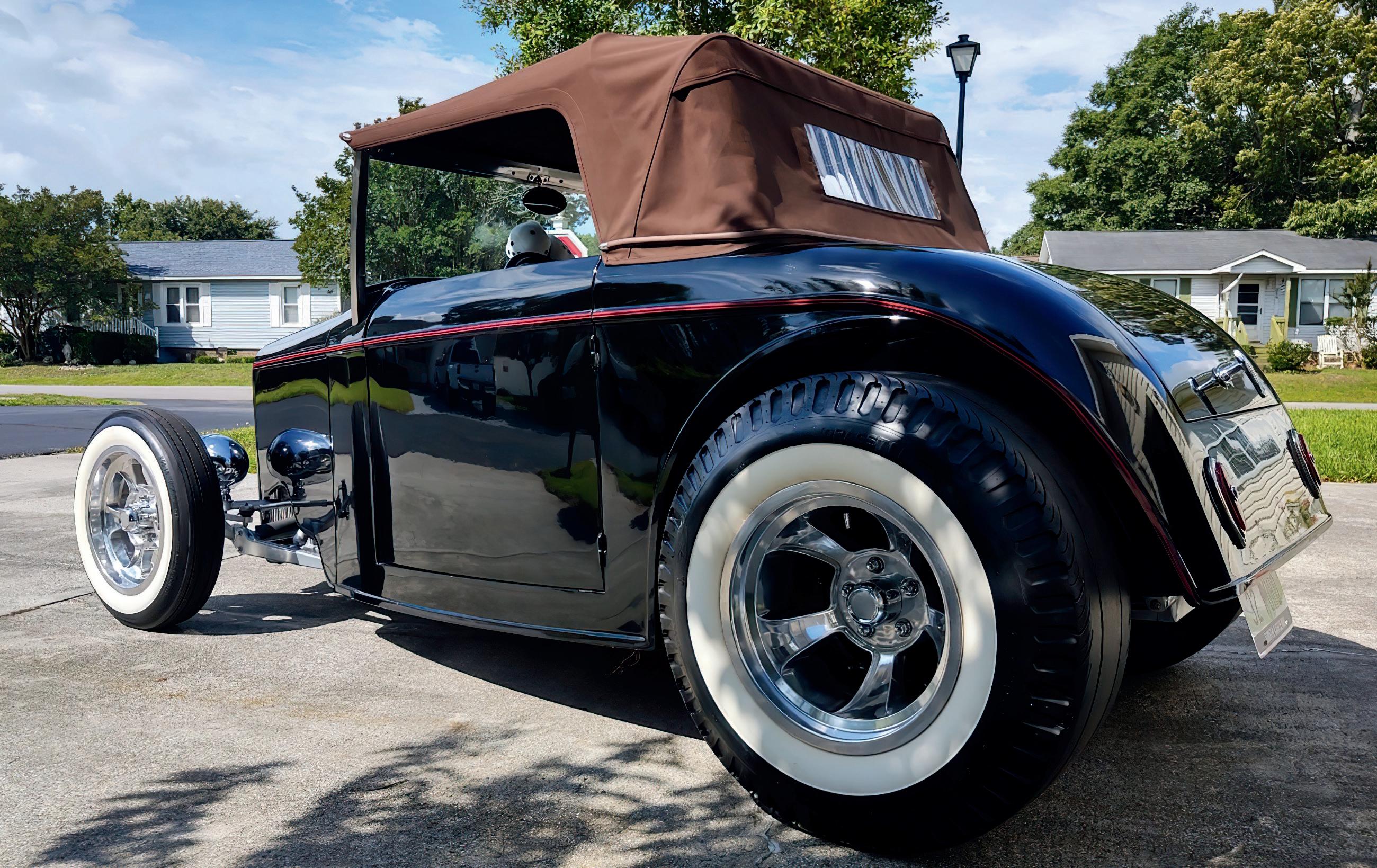
WHAT ARE YOUR FUTURE PLANS FOR YOU?
I do have hopes of one day starting a Custom Car Club right here in Murrell's Inlet S.C. Andy Fisher and I have begun plans and hope they come together.
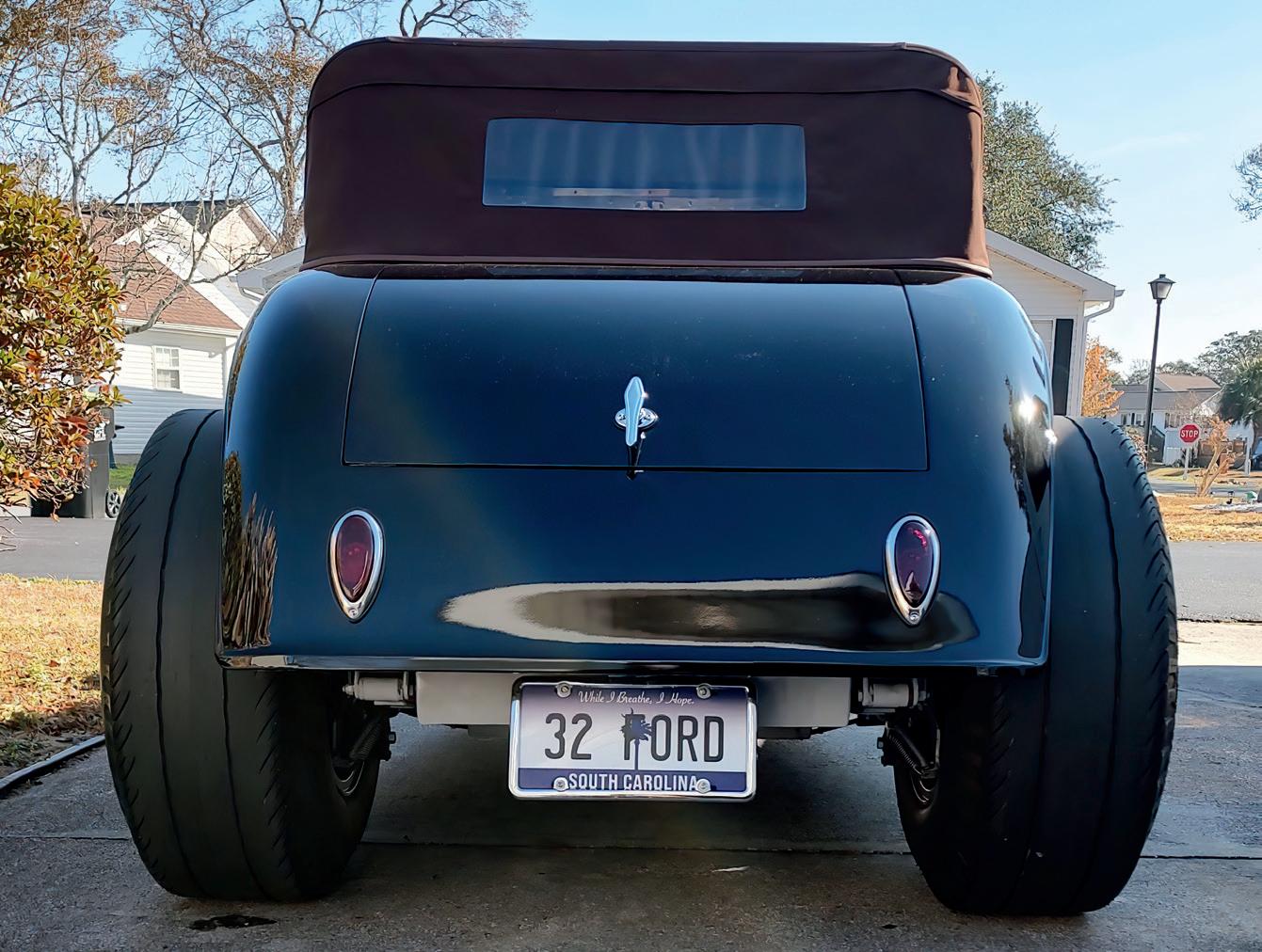

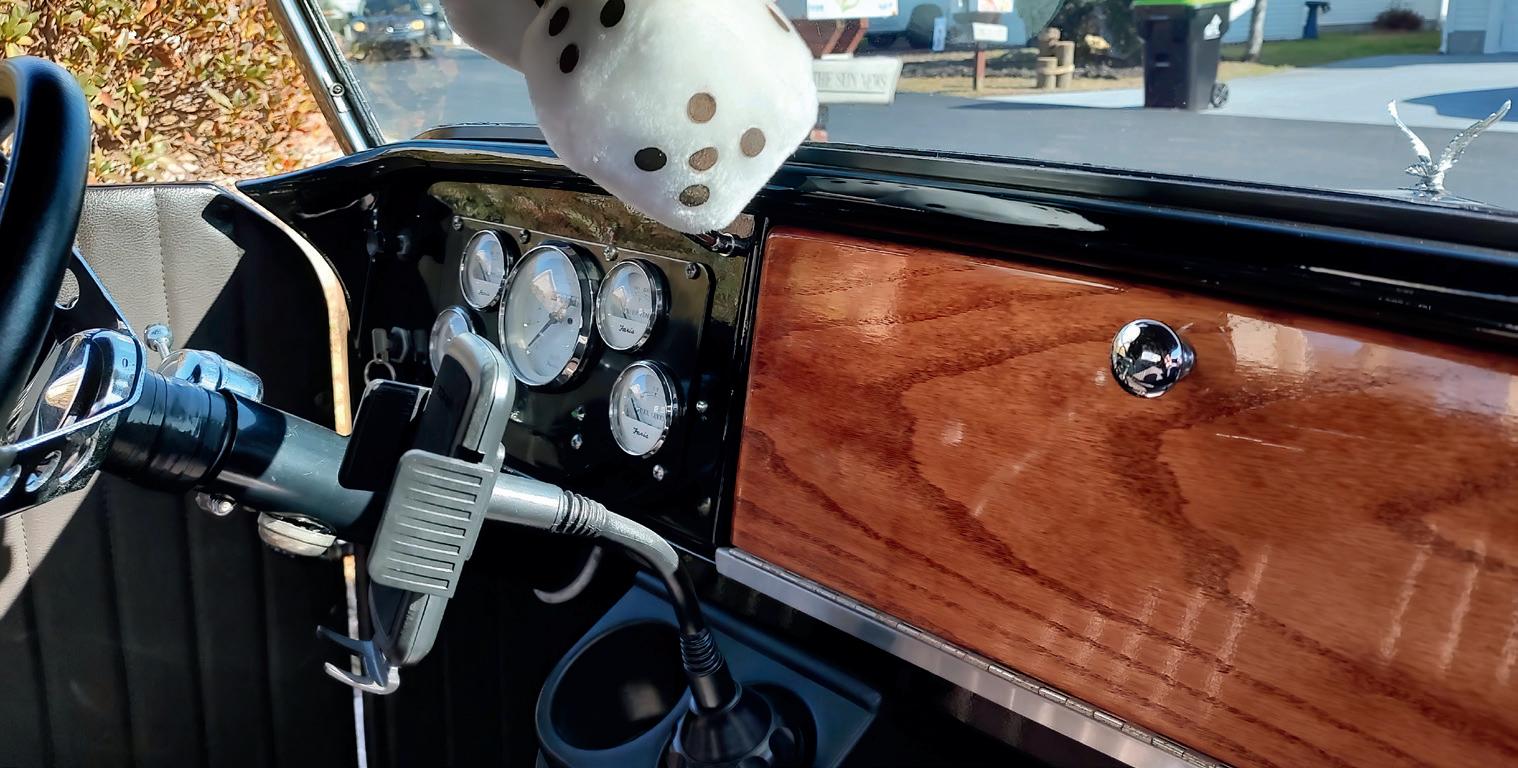
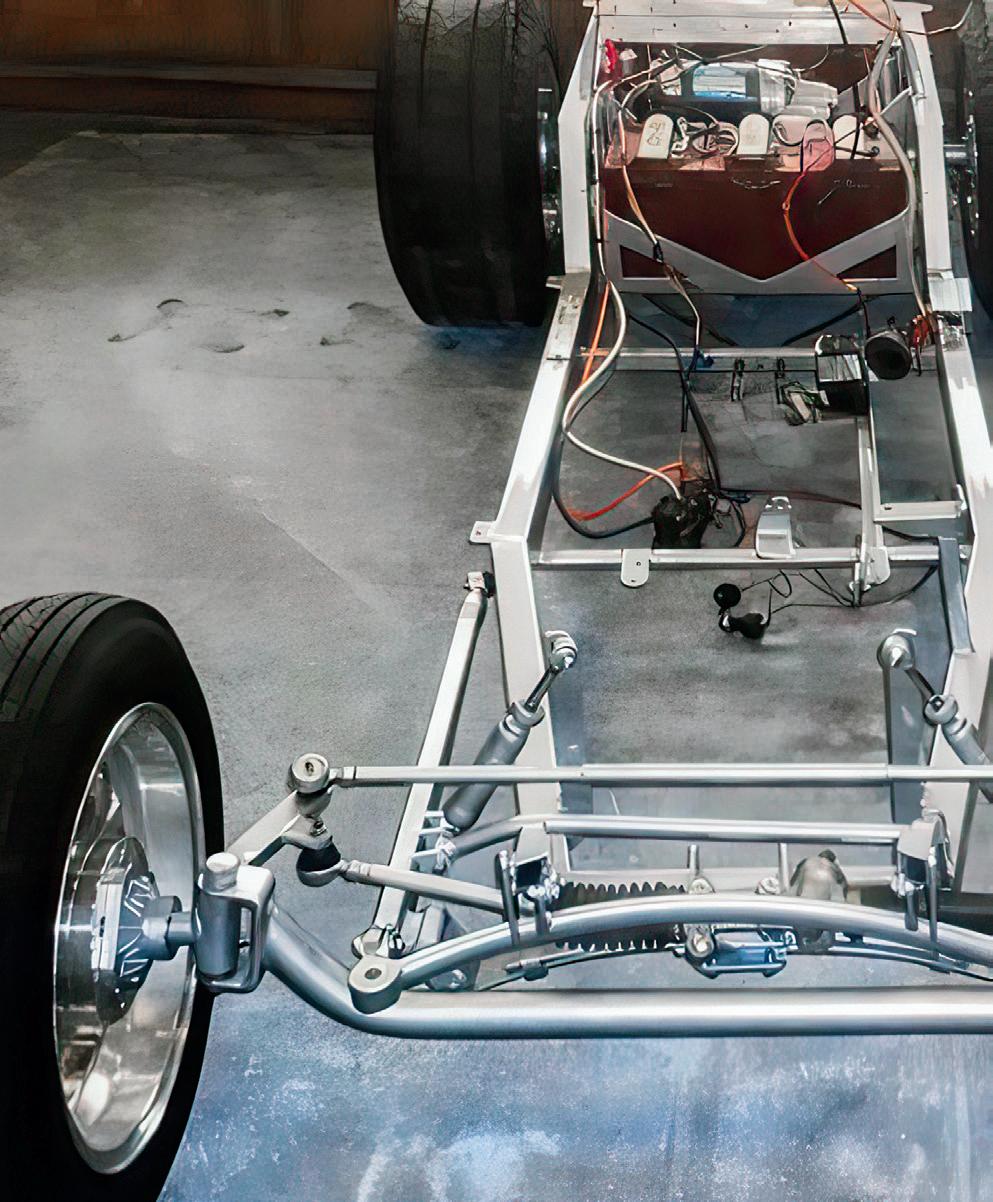
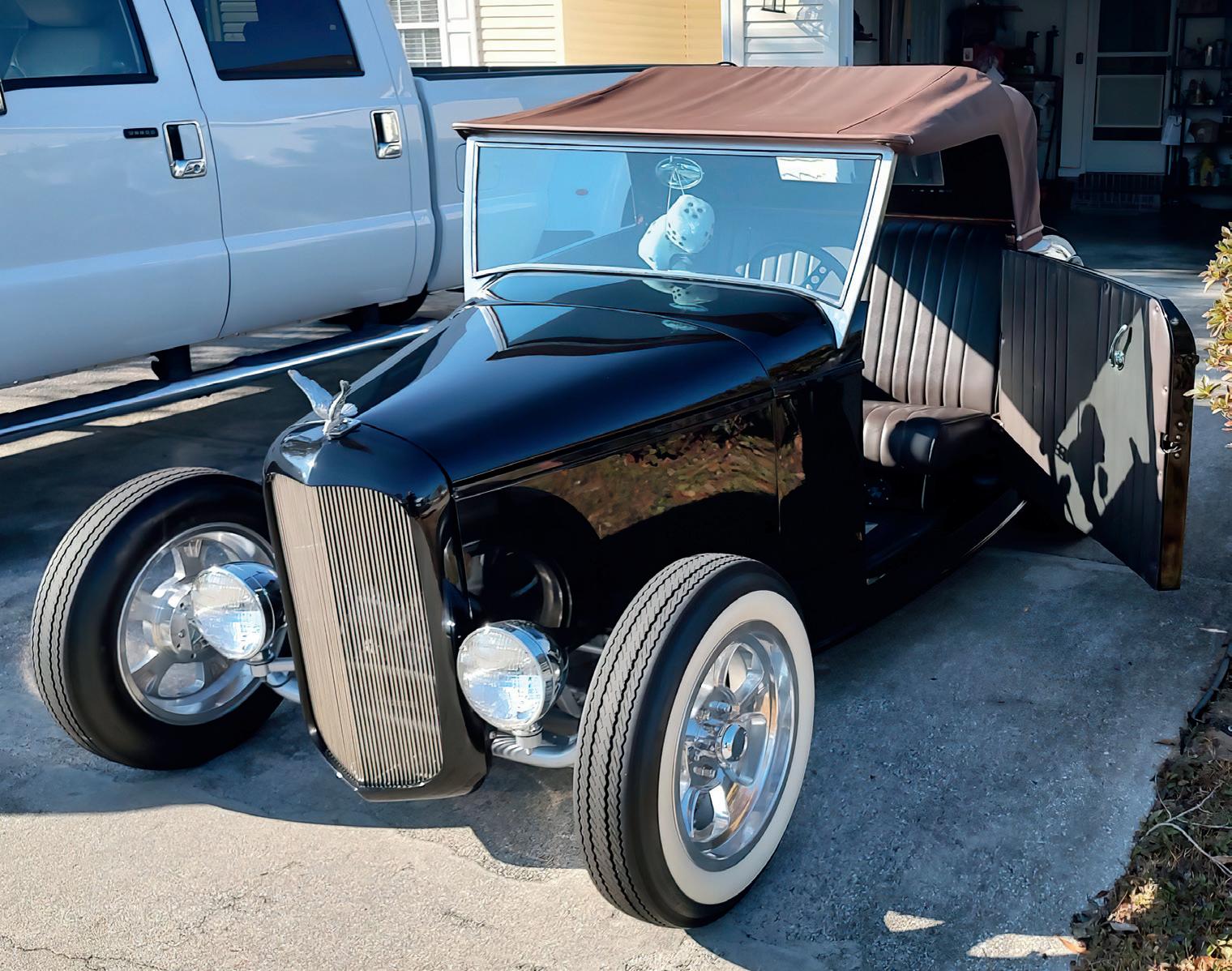
If you read our last issue of "How to build your own RC Golf Cart," I went through the steps of how I was able to build a mini golf cart for around $35. I found a 1/32 scale RC car and a golf cart toy that you can both get off Amazon. The golf cart was cool, but it needed some help on the performance side of things. Mainly, it needed help not flipping over while cornering due to the heavy die cast build of the cart body itself. So, wanting to lighten everything up, I decided that a fully 3D printed body was in order.
I fired up my 3D program – Blender -- and started engineering my favorite cart, a Club Car DS. Not only is this my favorite body style, but it would truly be an RC Golf Cart that no one else had. Once I engineered the cart to what I thought was close to the original DS body design, I started adding a few custom details. I added a rear seat kit with an extended roof, I printed some oversized tires out of TPU rubber filament to give
it a taller stance, and I painted the body with just normal rattle can paint to give it some contrast from the black.
Since I'm still learning how to use Blender and my 3D printer, it took many iterations to get what you see pictured today. I takes about 8 hours to print one body, and I have about 7 printed bodies that went to my plastic graveyard just to get a decent print and I'm still working on improving it every day.
My next project is to design a couple carts that I will print and then later use those designs to build two of the four beat up actual-sized carts I have stored in my backyard. One will be a low rider and the other will be more for off-road use.
Aside from my original cart and the 3D printed cart, I also built two additional carts that I had in my cart collection and put them on two different RC car/Jeep. Read on to learn more.
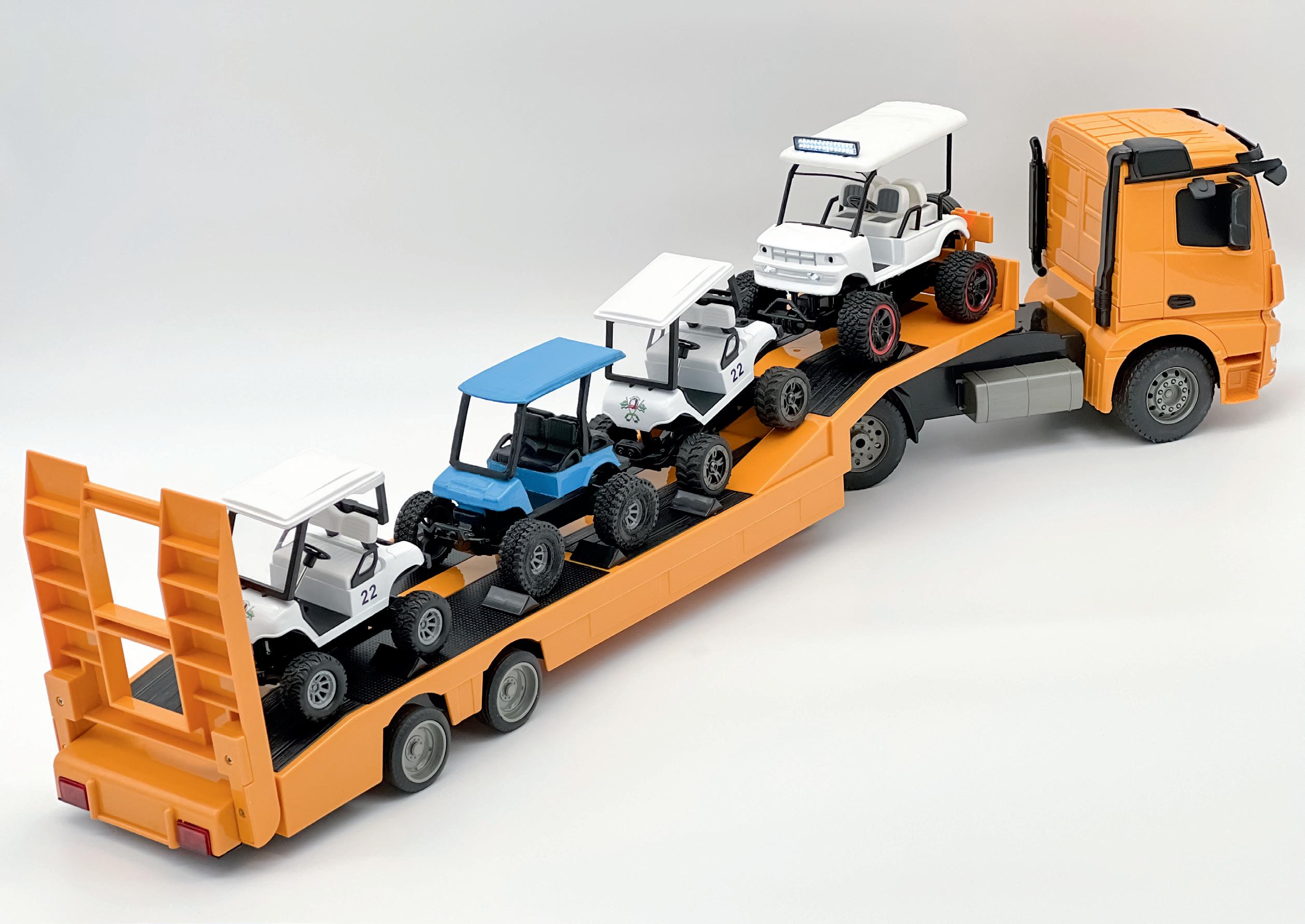
CART 2: This cart uses the same RC chassis as the original build cart (Cart 1). I designed the cart using the same attachment points as Cart 1 to the RC chassis. To get some of the details of the Club Car DS to look right when it was scaled down, I had to make the body lines bigger and more pronounced. Otherwise, they get lost. For example, this printed cart I had detailed the front with the headlight kit which had the bezel, headlight, and blinkers, and in the final print it looks like nothing. The roof uprights are about 10 times thicker than the scaled version, but I think they look better a little chunkier.
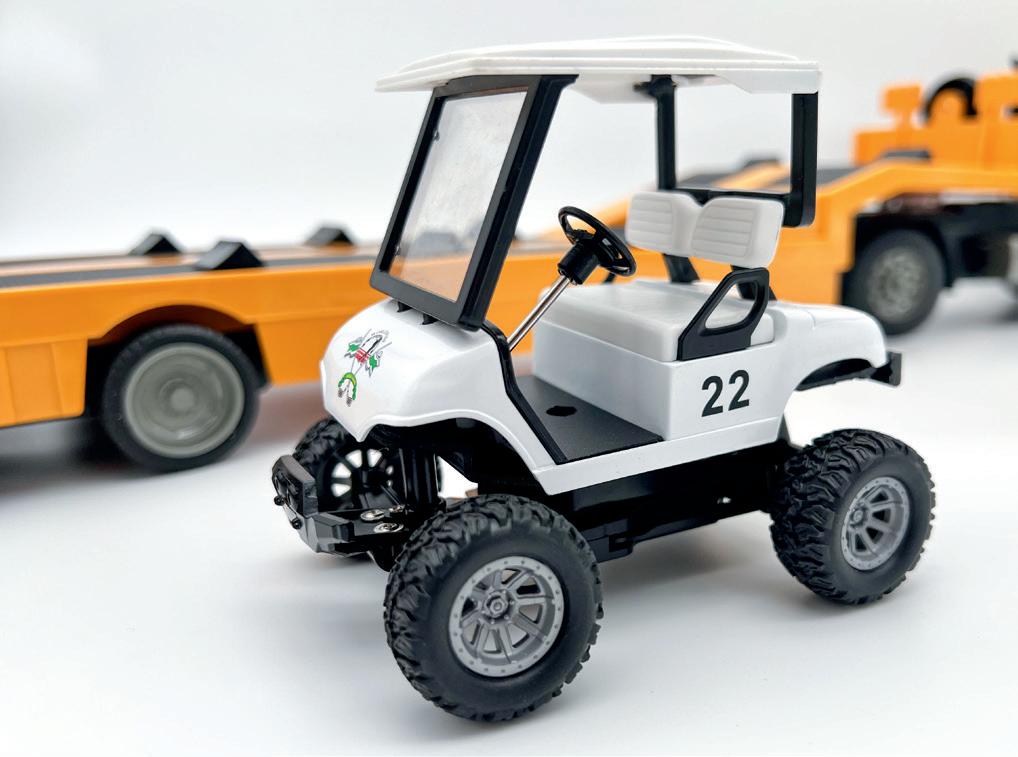
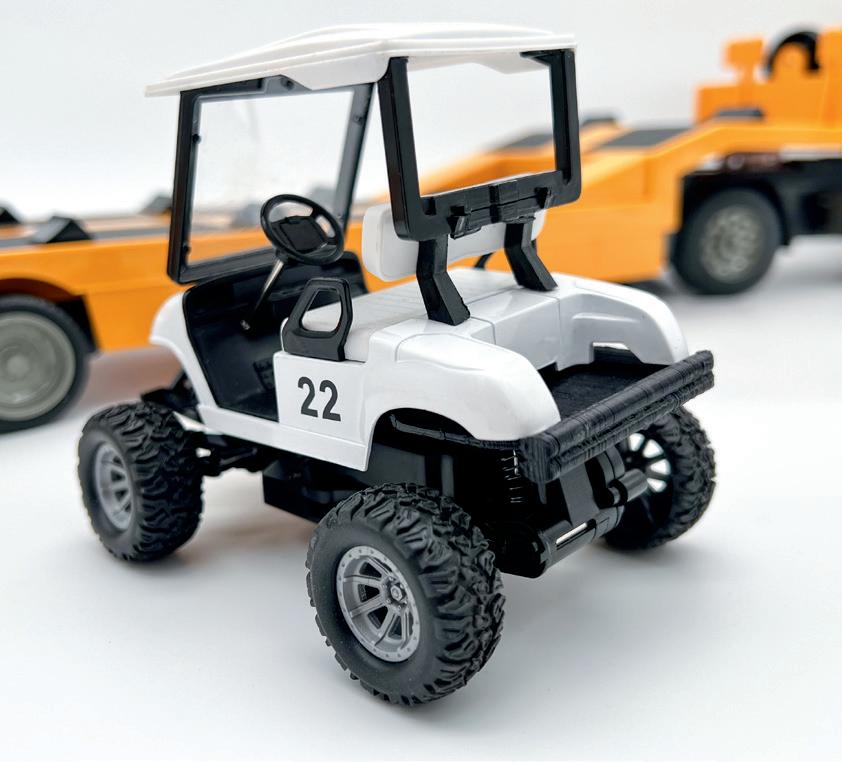
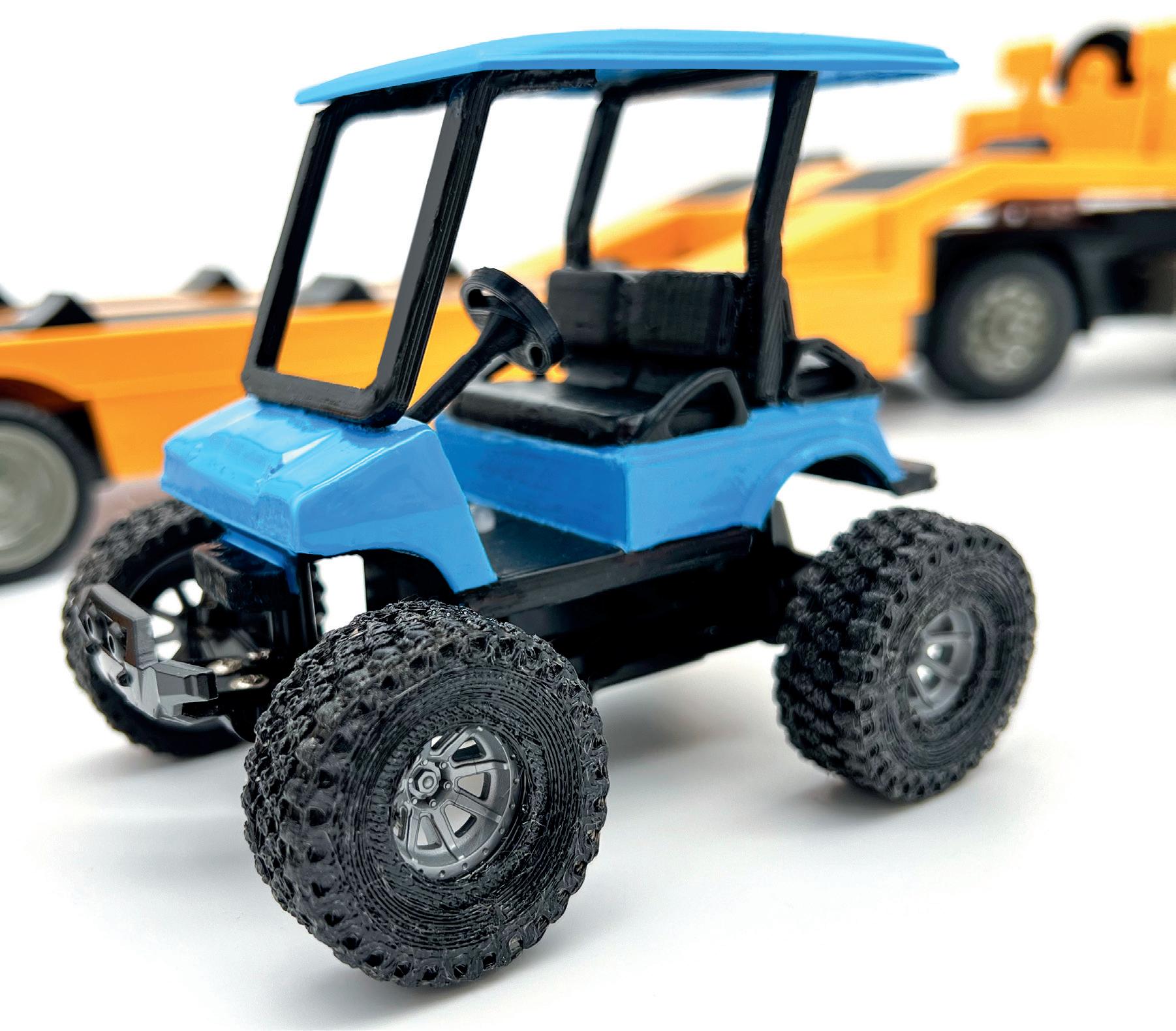
CART 1: This is the original cart in last month’s issue, and it was simple to build a sub-frame that would connect the body to the RC chassis. You don't have to go as far as I did and 3D print it. You could probably use some thin metal and bend it and hot melt glue it together to get the same results.
I also experimented with printing out some rubber tires. I think they look pretty good compared to the smaller old tires, although they don't have the same soft grip as the originals.

CART 3: This body is a twin of the original cart but with a different RC chassis. I really like this RC chassis, but it was a lot more difficult to adapt the body to the RC. The tires have more flex in them. They are more squared off than Cart 1, which translated to more stability while cornering and it drives over dirt with ease and is faster overall. The feature that I really liked was that it had lights in the front, rear and top. I haven't worked out wiring the lights for the roof and rear, but the front yellow lights are standard.
I hope you like my little experiment into building some RC Golf Carts. If you have any questions, you can write me at troy@golfcarting.com.
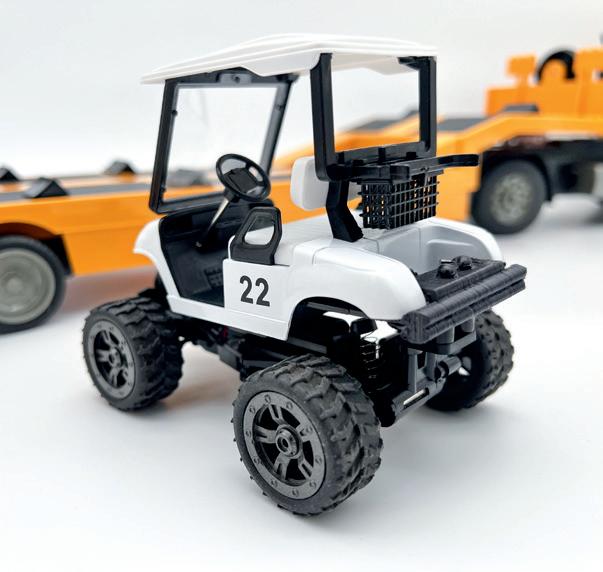

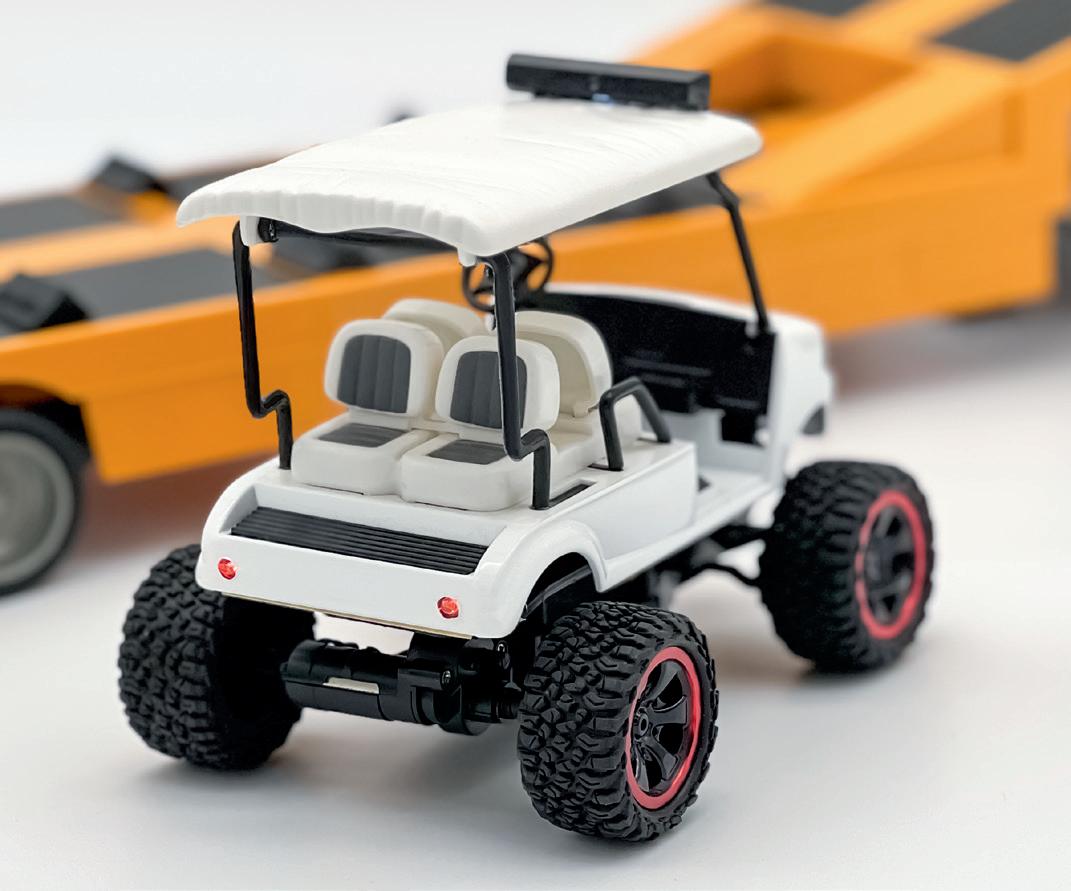
CART 4: This cart body I have had for many years, and I can't find it anywhere, so it is a unicorn. I bought an RC Jeep off an auction site and not knowing the size of it, I was happy when I got it home and found out that the Jeep chassis would fit perfect under this cart body. As a bonus, it had a cool light bar and front and rear lights that where easy to hook up. I think it turned out pretty good, but the body is heavy and bottoms out the suspension so I'm looking for some stiffer rear springs to help with the sag. The lights are super cool and bright in the dark. It has a cool feature that when you turn right the right taillight blinks and turn left the left taillight blinks.
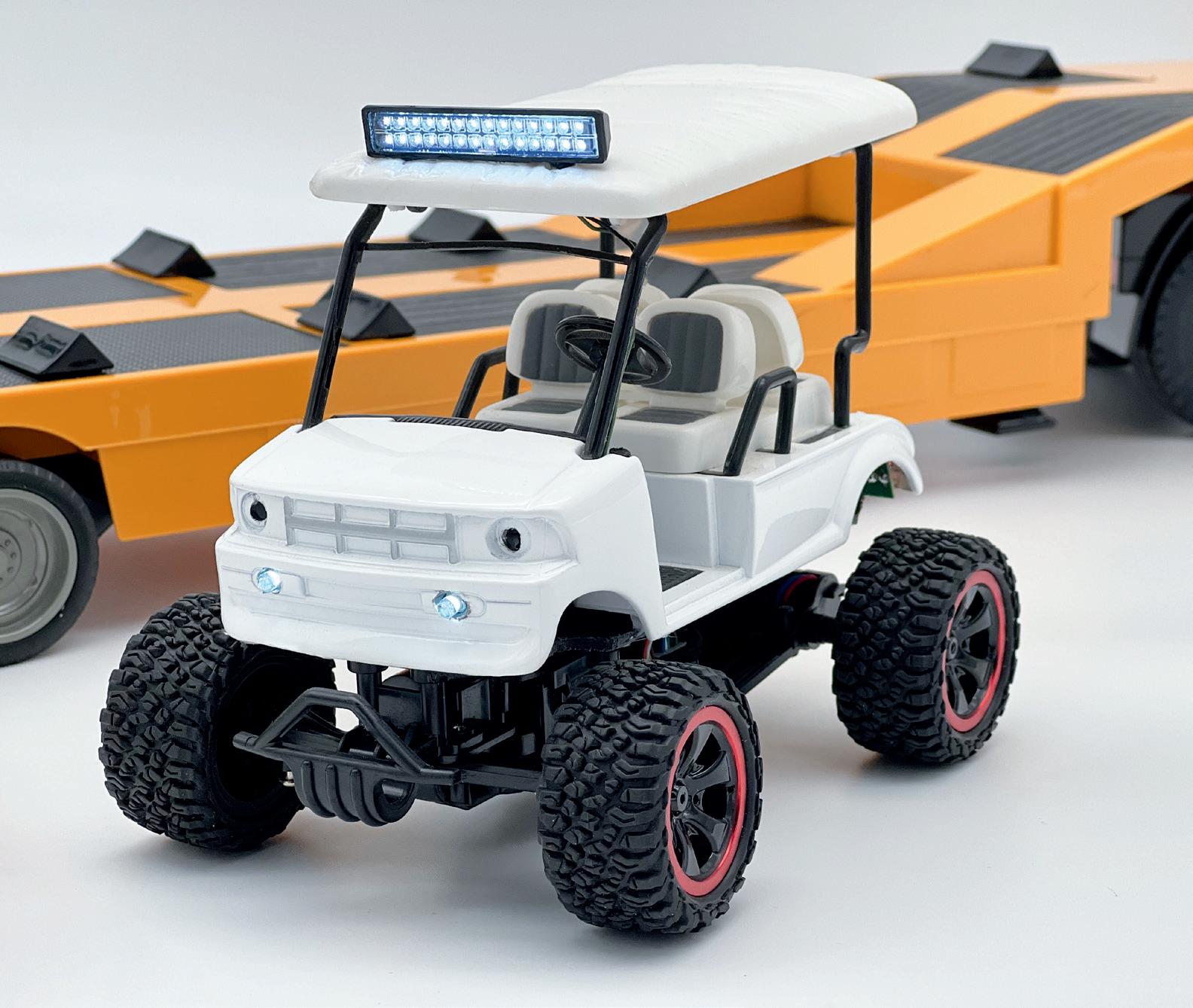
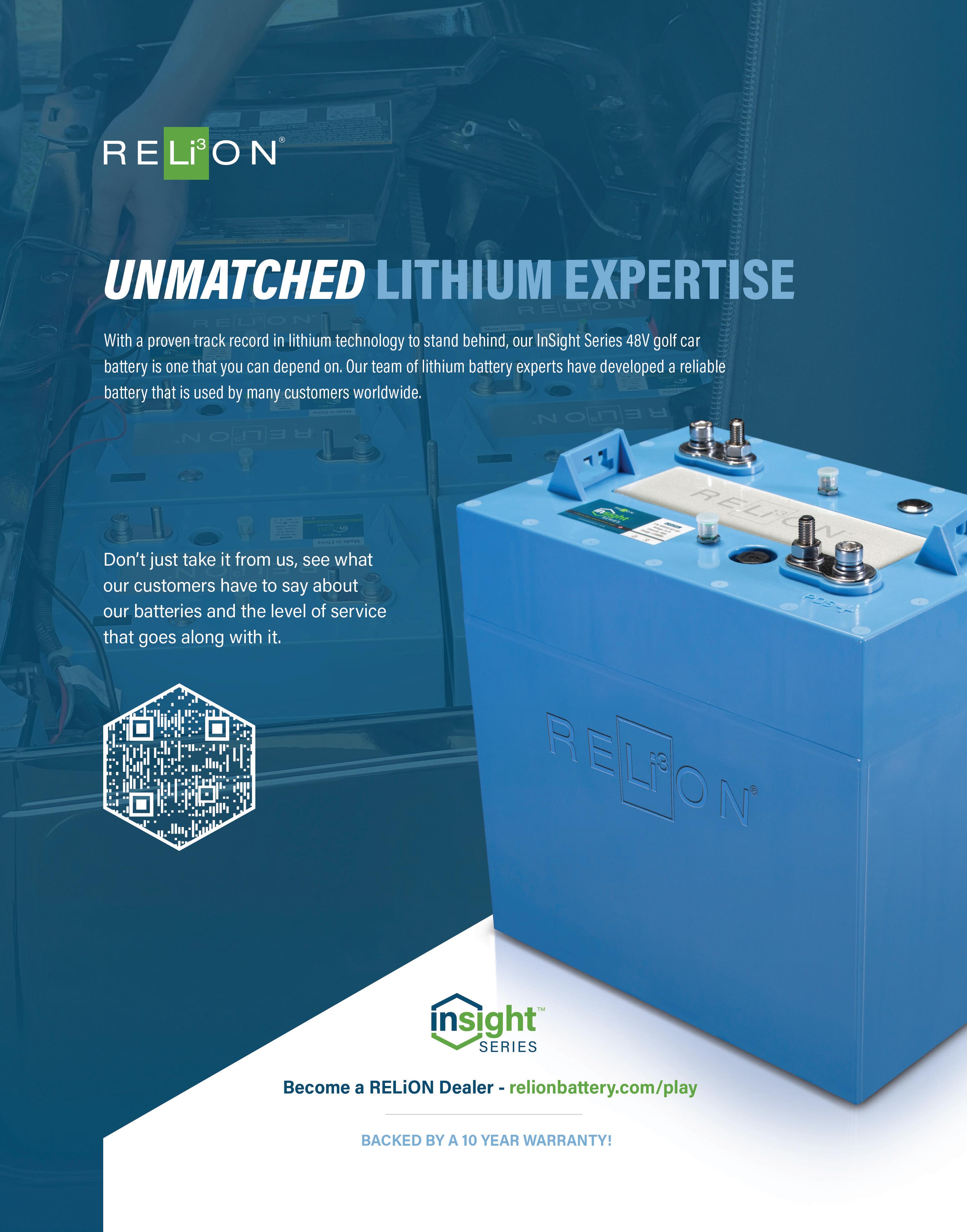
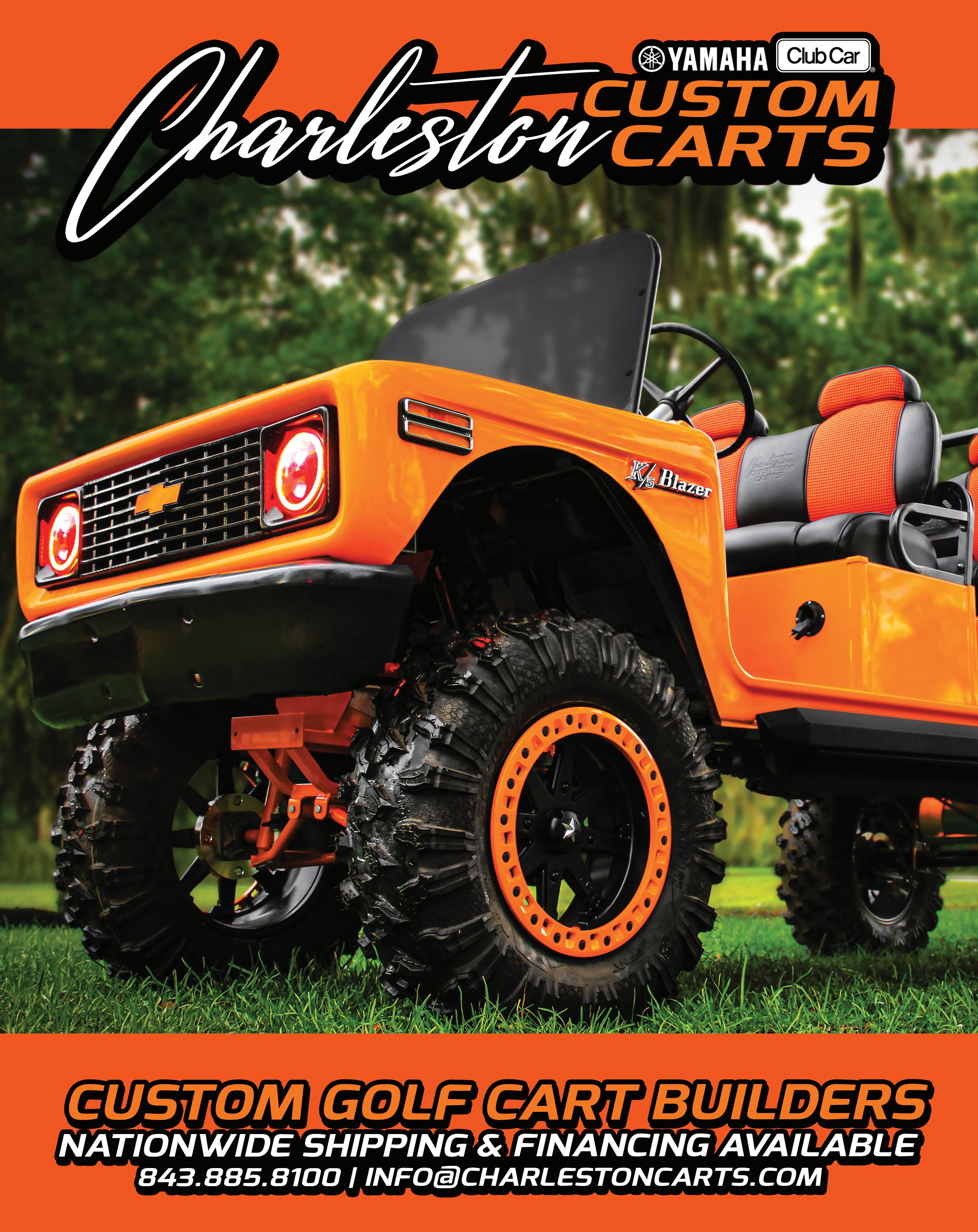
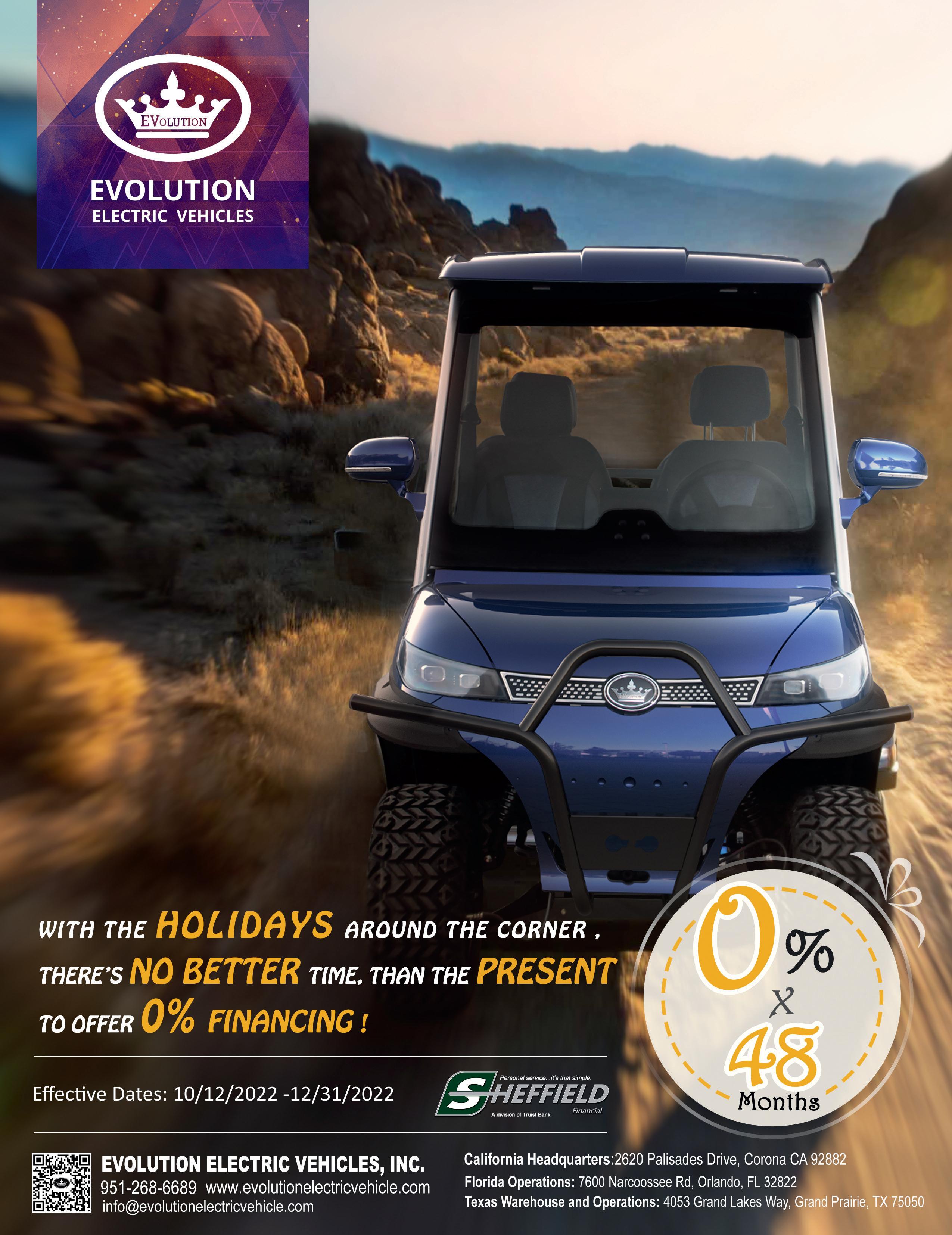
Q: I'm looking for an enclosure. What are my options?
A: Enclosures are available in a variety of materials and colors. The easiest and most inexpensive ones are installed over the existing top and hook underneath the vehicle and Velcro to the upright roof supports. The more universal design of this option can work on several types of carts as well. The custom fit types have a more permanent style installation where tracks are installed on the roof that panels attached to the enclosure slide into. These are generally a more secure enclosure and prevents the flapping of panels in the wind. They typically use zippers or Velcro to secure the doors. For those looking for a premium enclosure, companies such as DoorWorks use an actual door frame that creates a much better user experience as well as increased visual appeal, not to mention increased durability.
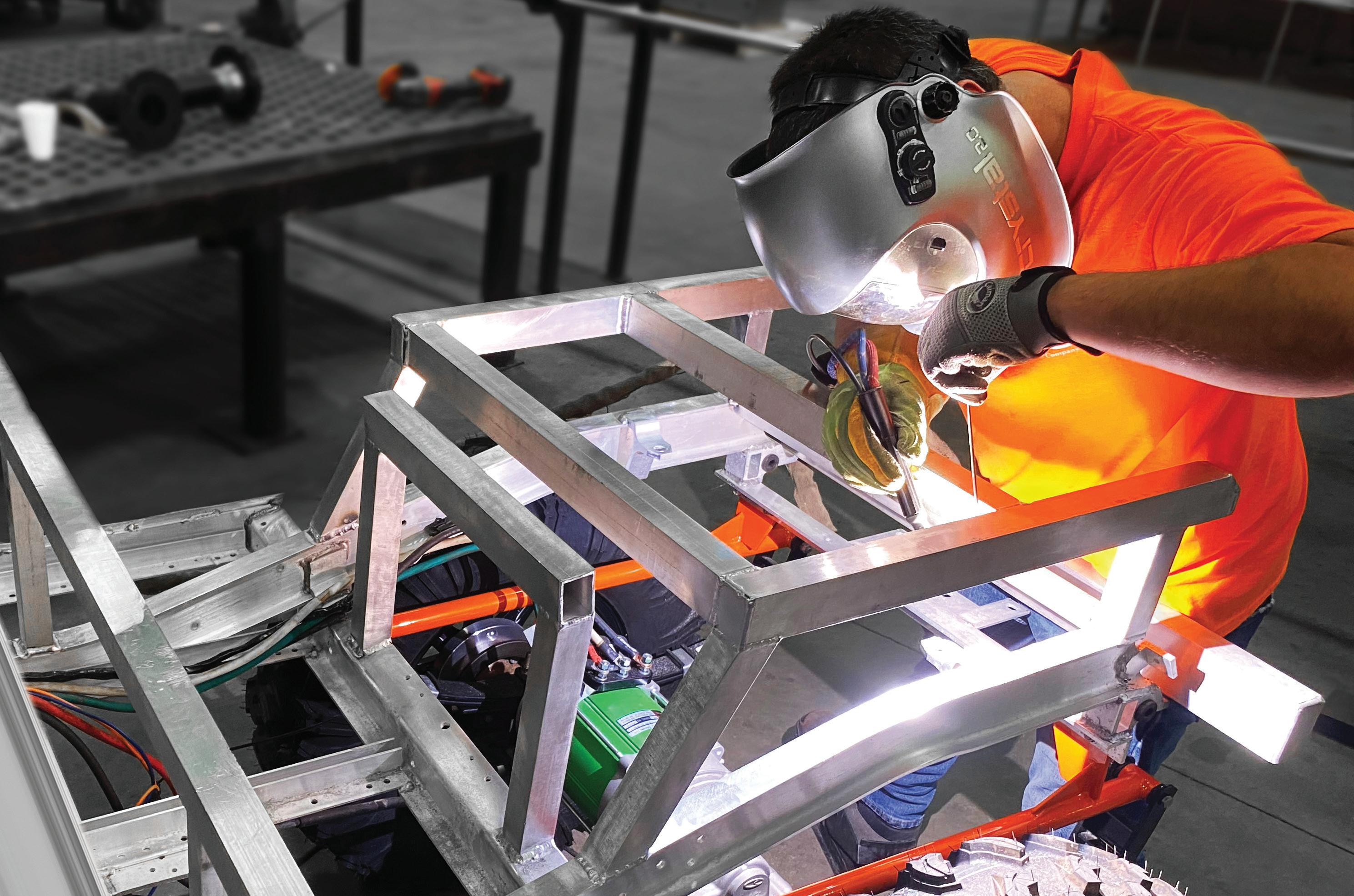
Q: My rear springs squeak on my EZGO, especially over bumps. Why is this happening and how can I fix?
A: More times than not, the rear bushings in the leaf springs need to be replaced. Over time, these bushings connecting the springs to the frame will wear down and fall out. Look closely at your shackles, (the metal bars that hold the spring to the rear frame) if they do not have rubber between them and you see the leaf spring eyelet resting on the bolt that holds them in place, you need new bushings. Simply jack up the rear end to take the weight off the springs, (paying attention to block the front wheels) but not too much. Just enough that the bolt
is in the middle of the spring so you can take the two bolts out. Then add the four top and bottom bushings to the end of the leaf springs and bolt them back in place. The front ones can be a tad bit trickier because you have to make sure the spring is level but essentially it is the same procedure. Pro tip: If your bushings are too tight to go inside the leaf spring eyelet, use dish soap or WD40 to slide them in easier.
Q: Do I need a separate battery in my gas cart for a stereo?
A: I usually recommend adding a separate battery. The reason is when your cart is moving the battery is charged by the generator. However, this can create EMI interference in the cart and voltage spikes when starting and stopping with sensitive electronics. You can add a capacitor and regulators if you'd like but generally, I have had better luck adding a separate 12v battery in an alternate location. The upside to this is having the assurance that if you park your cart for an extended period, you can play your music without worrying that it will drain the battery enough for it not to start. The only downfall is that you will need to charge this alternate battery separately. That being said, it also adds a backup battery in case you ever do get stranded by your main battery.
Feel free to ask us any questions by Facebook messenger or email tony@golfcarting.com. Happy carting everyone!


